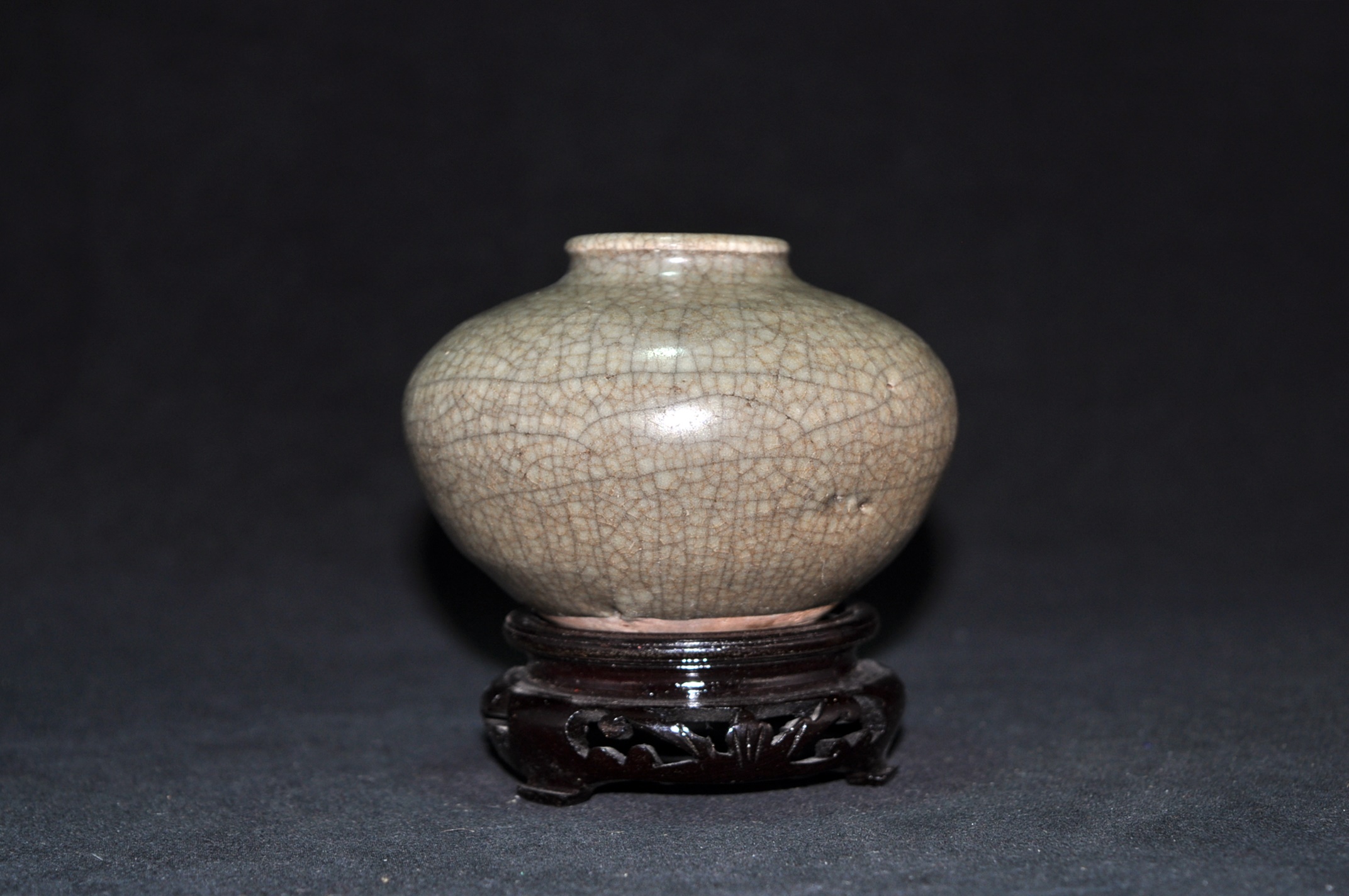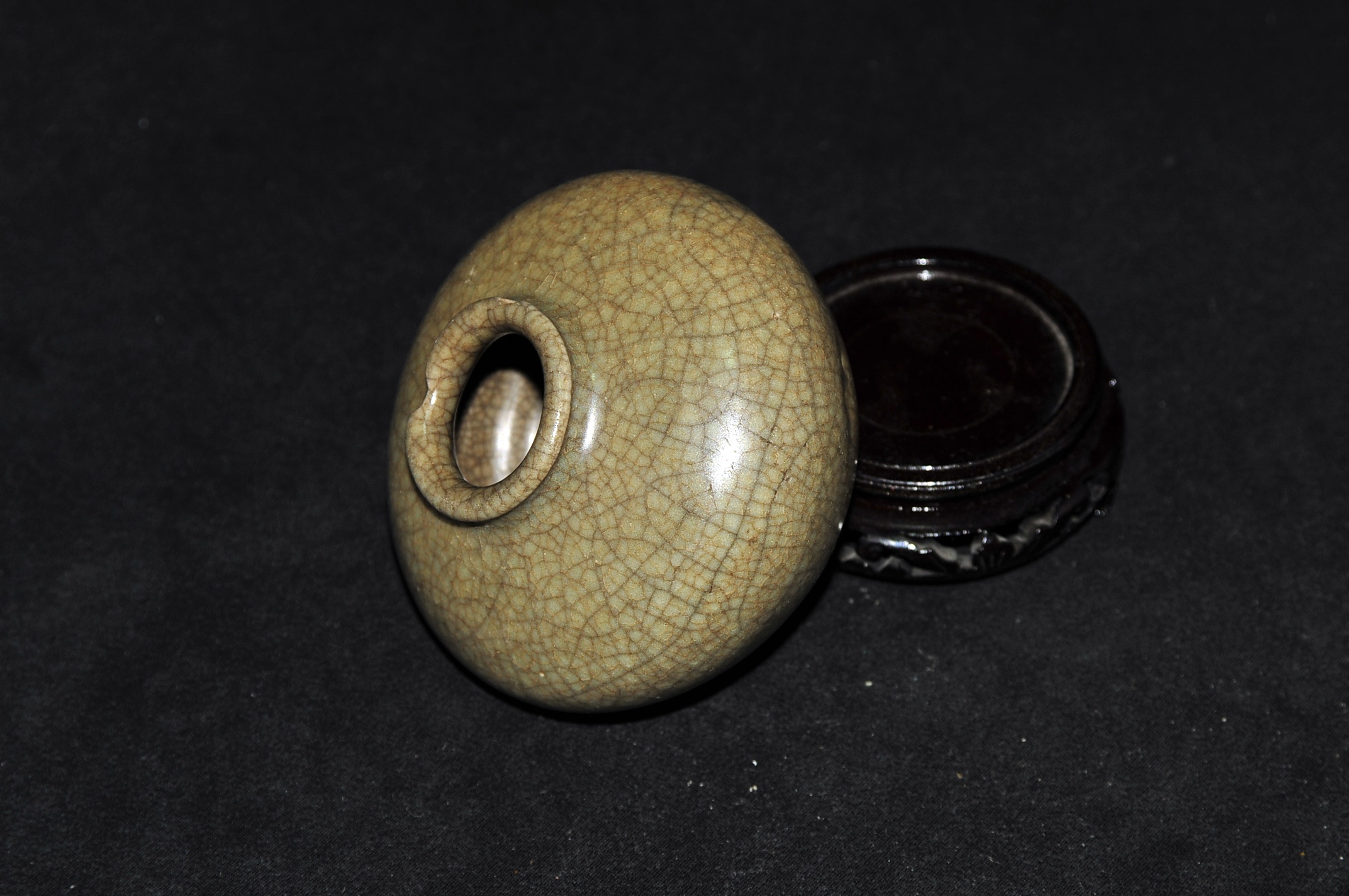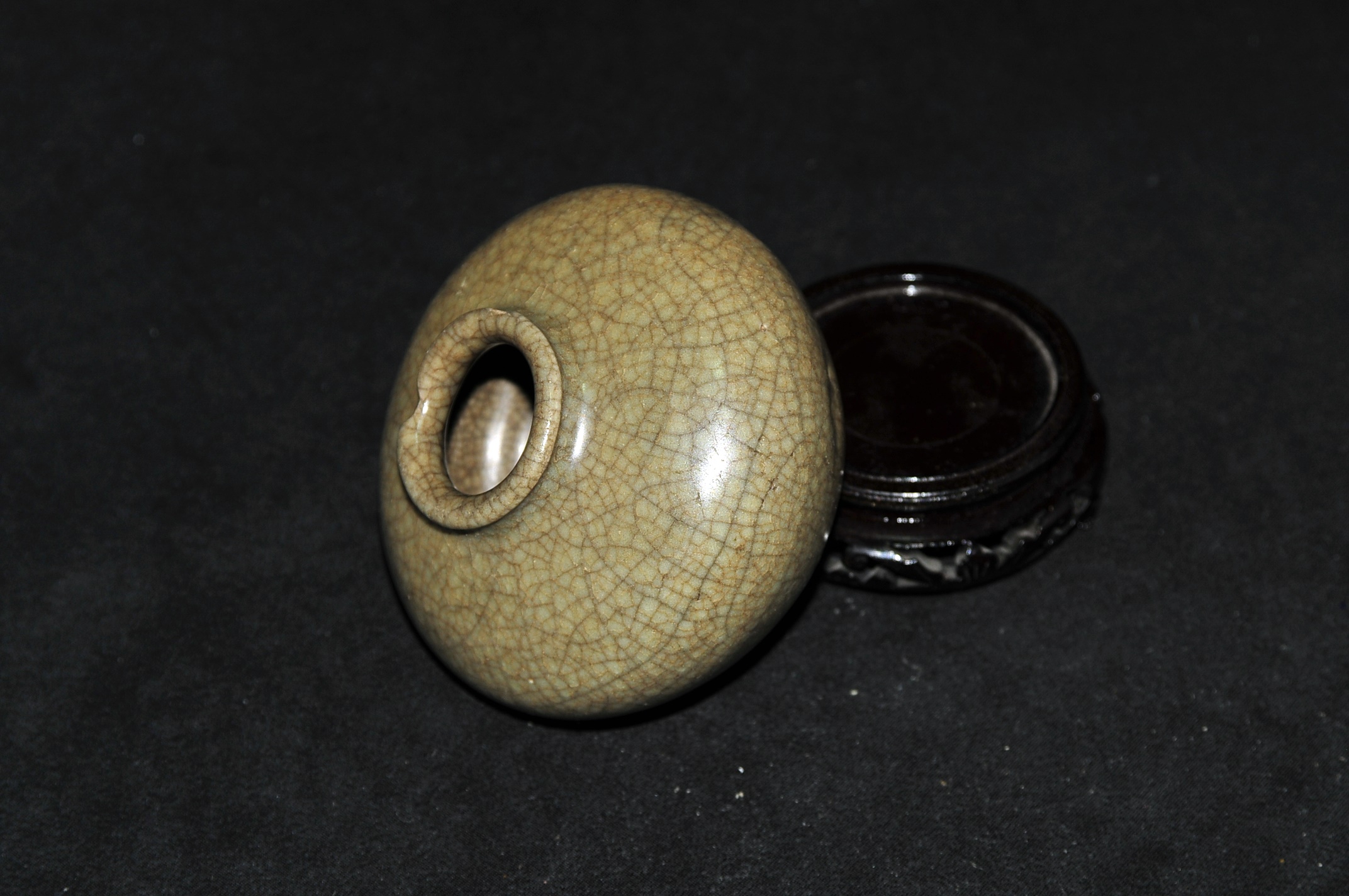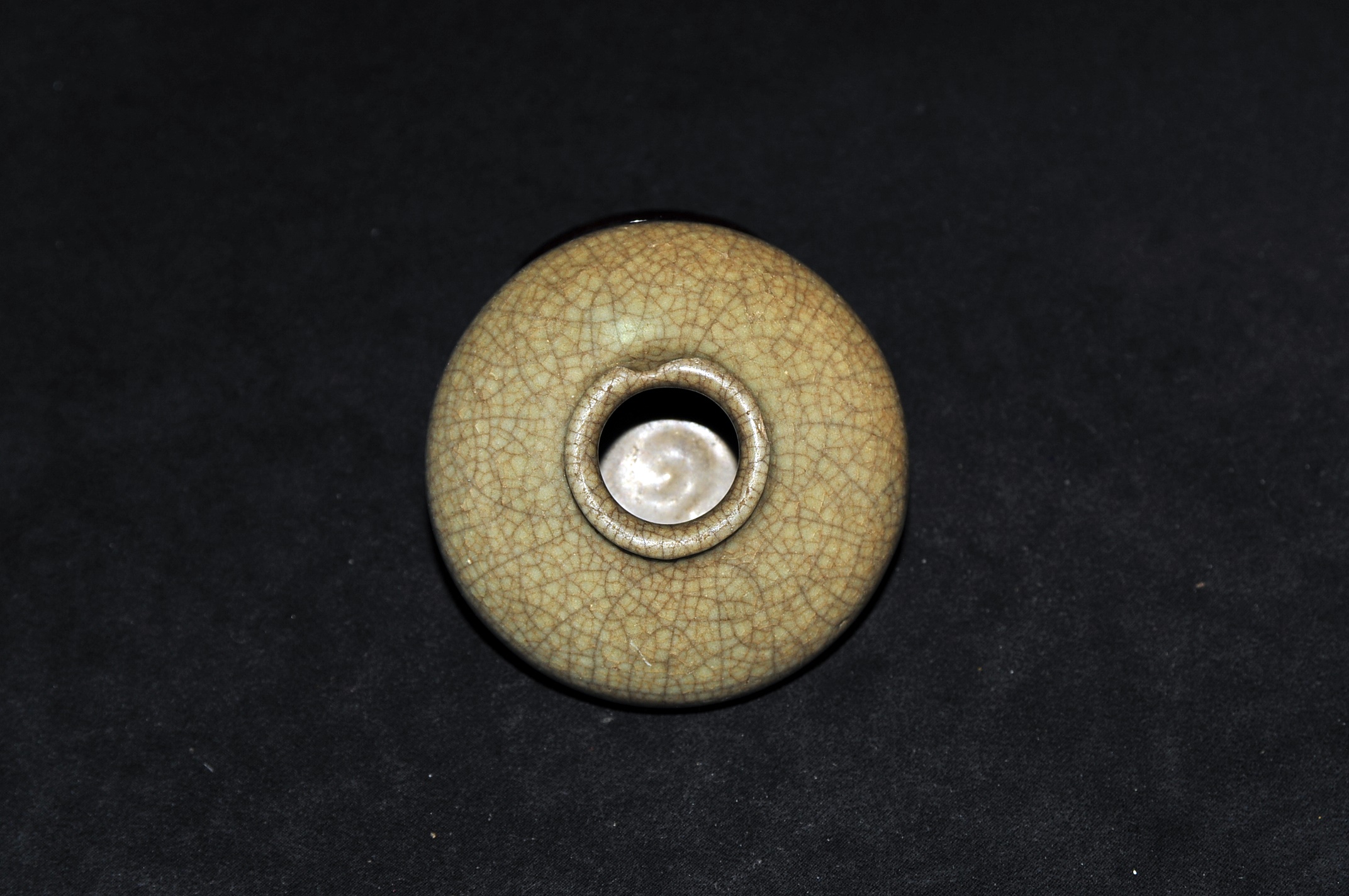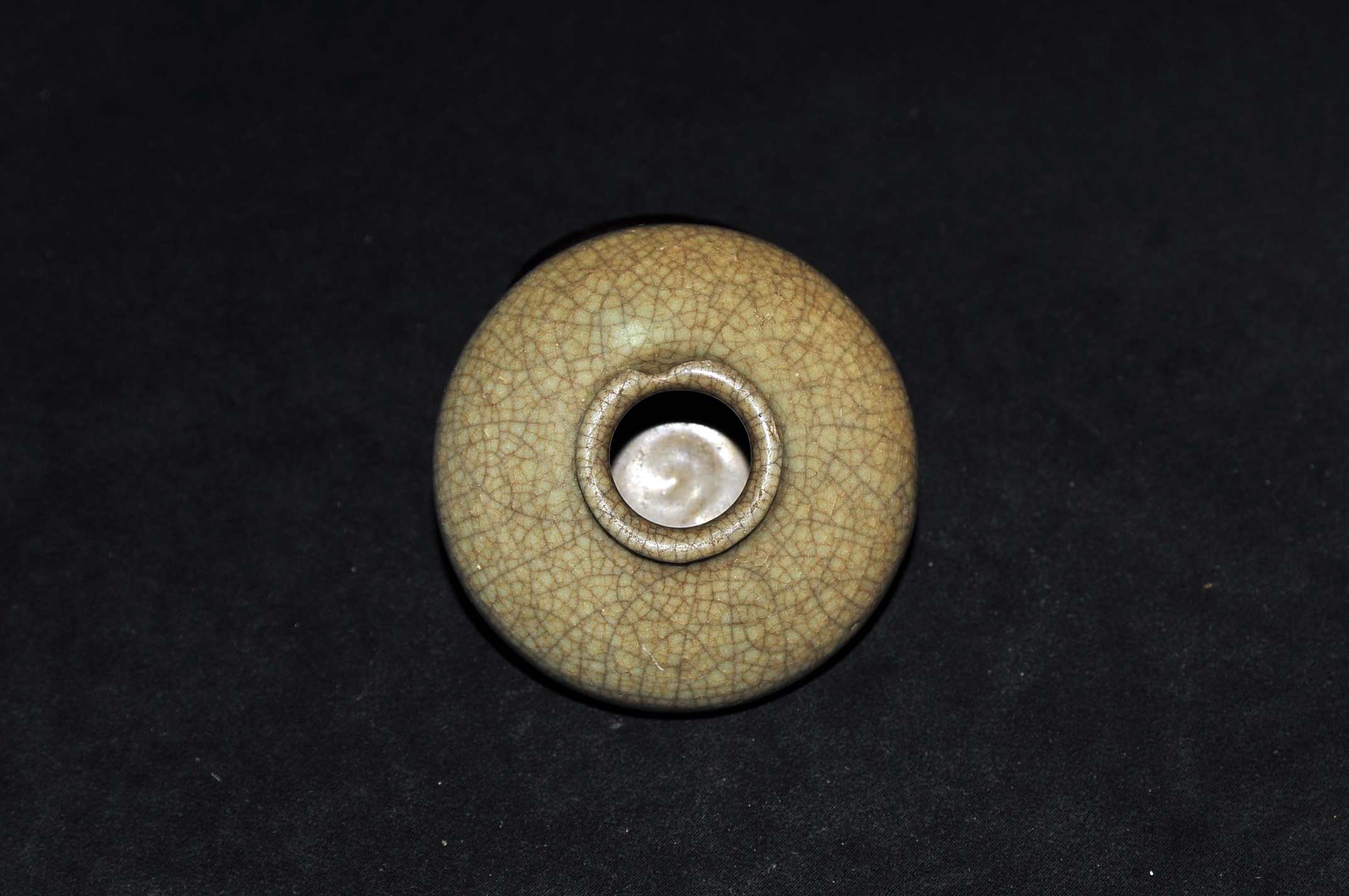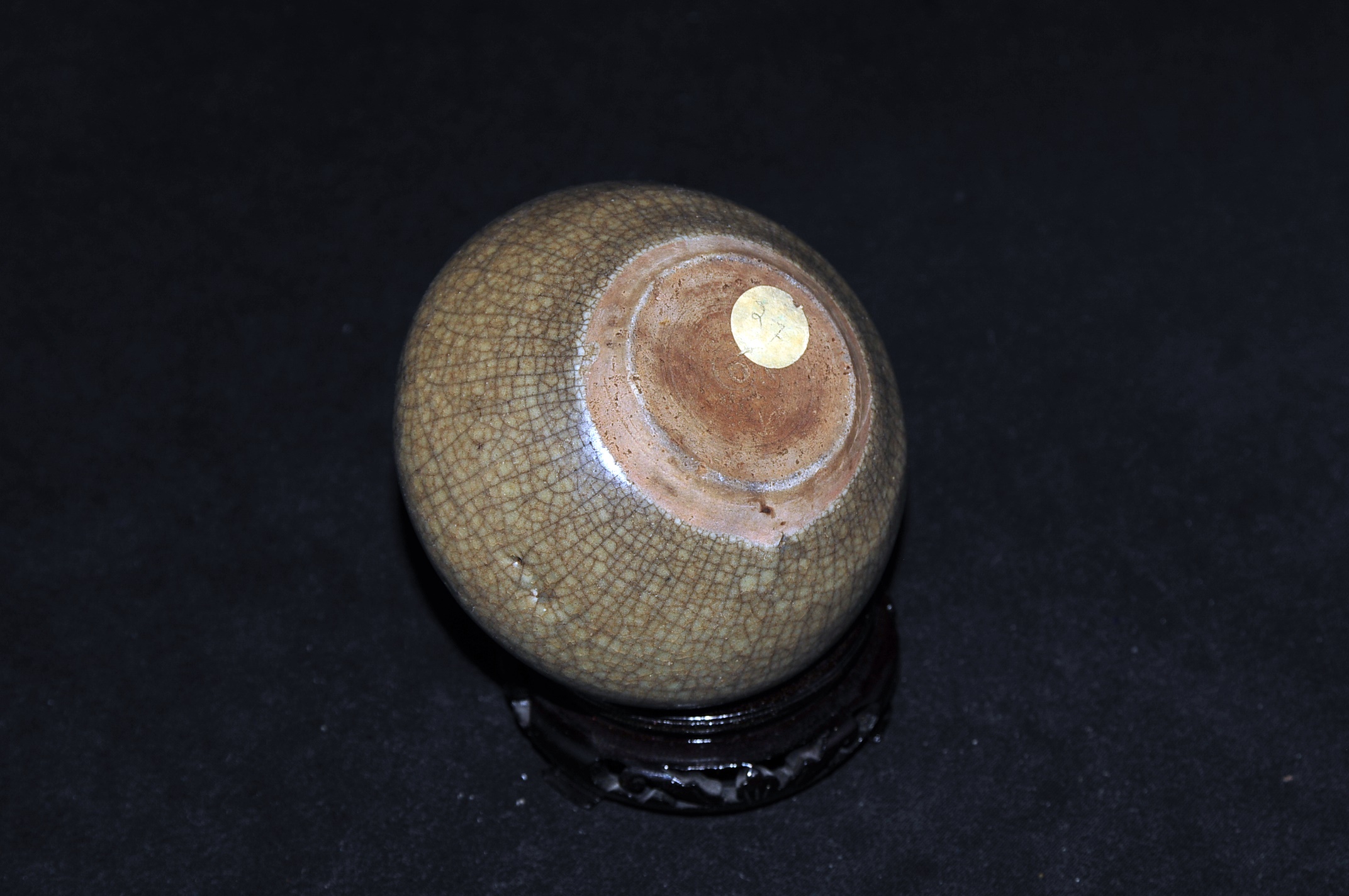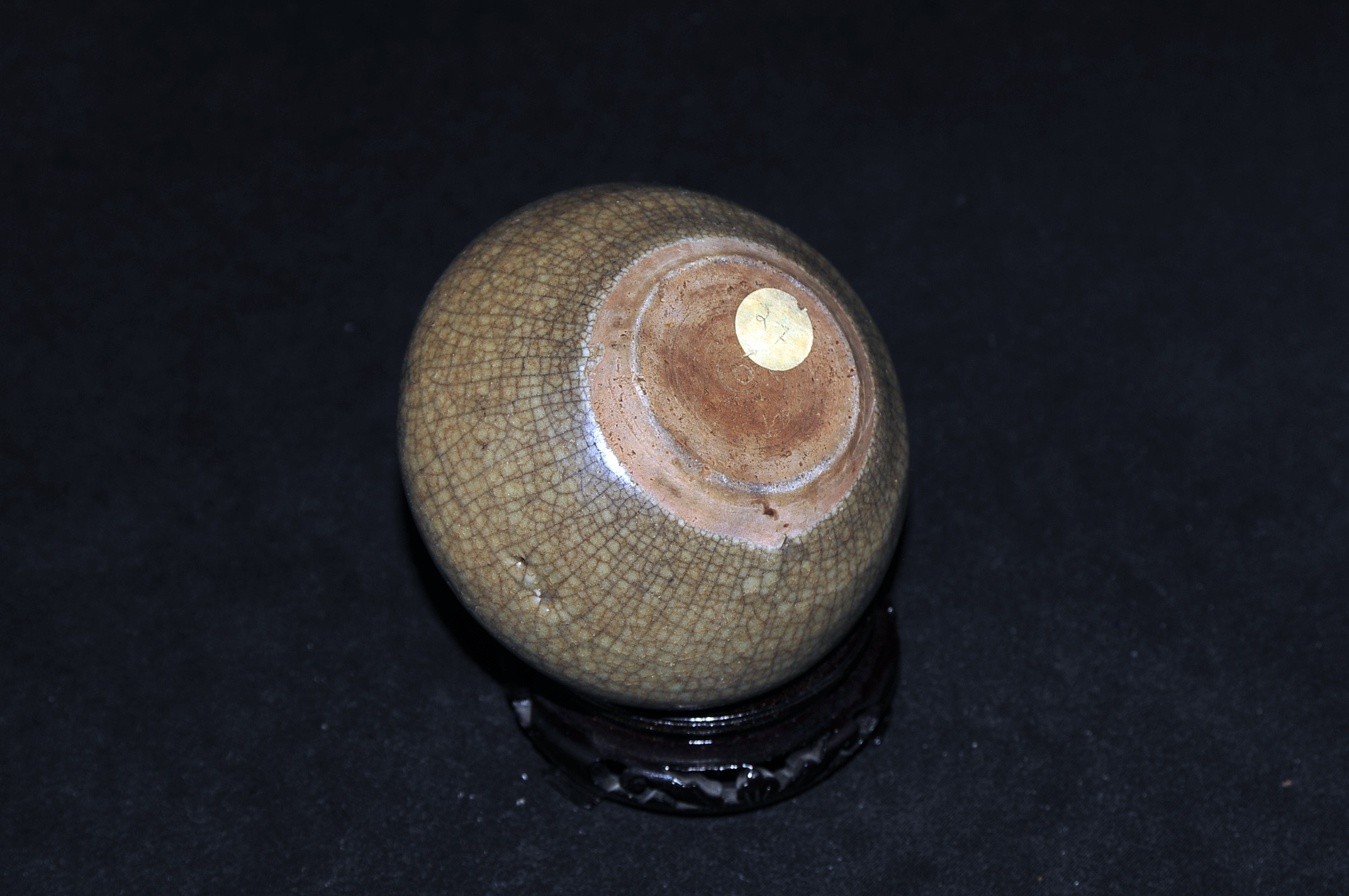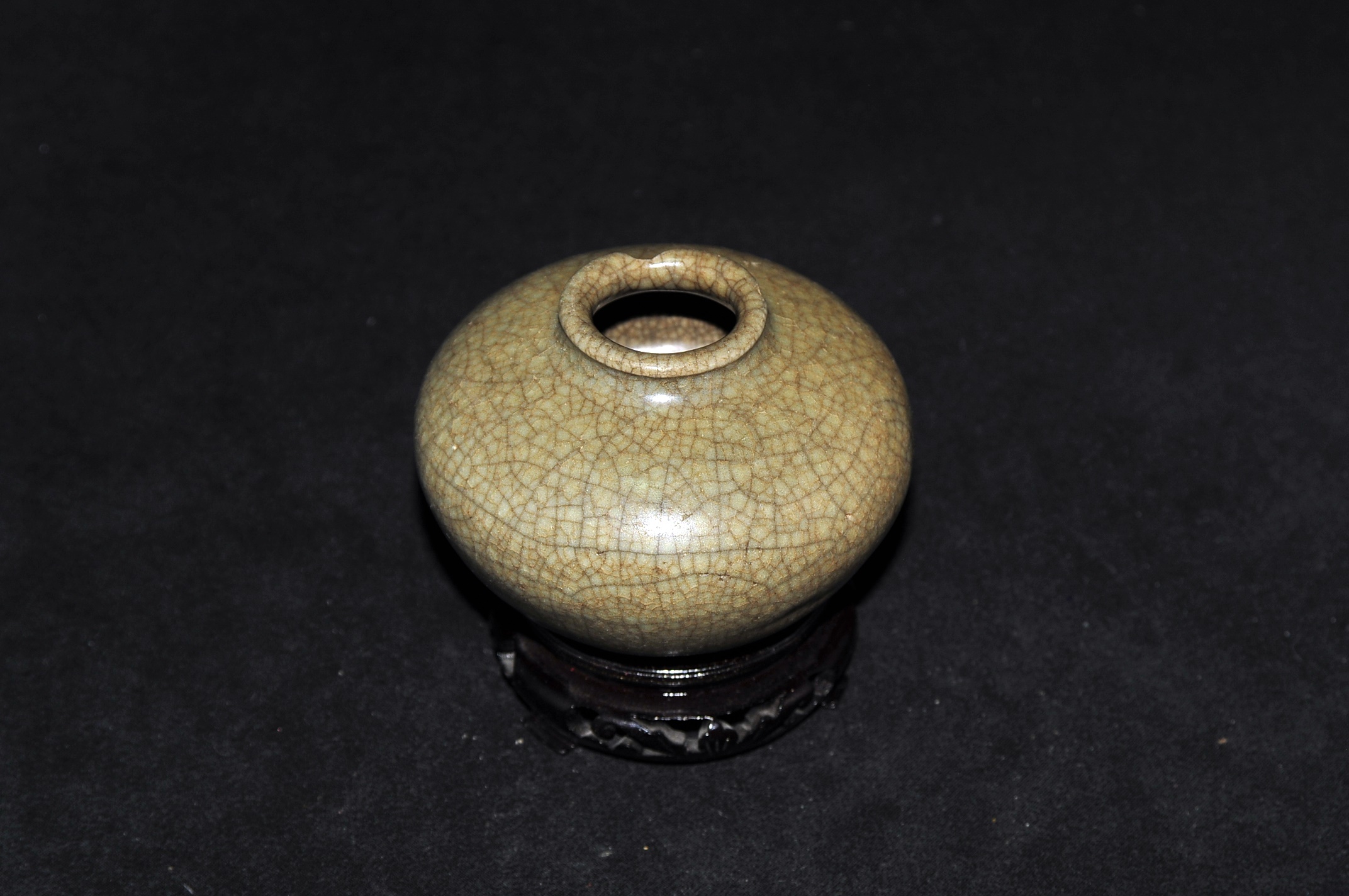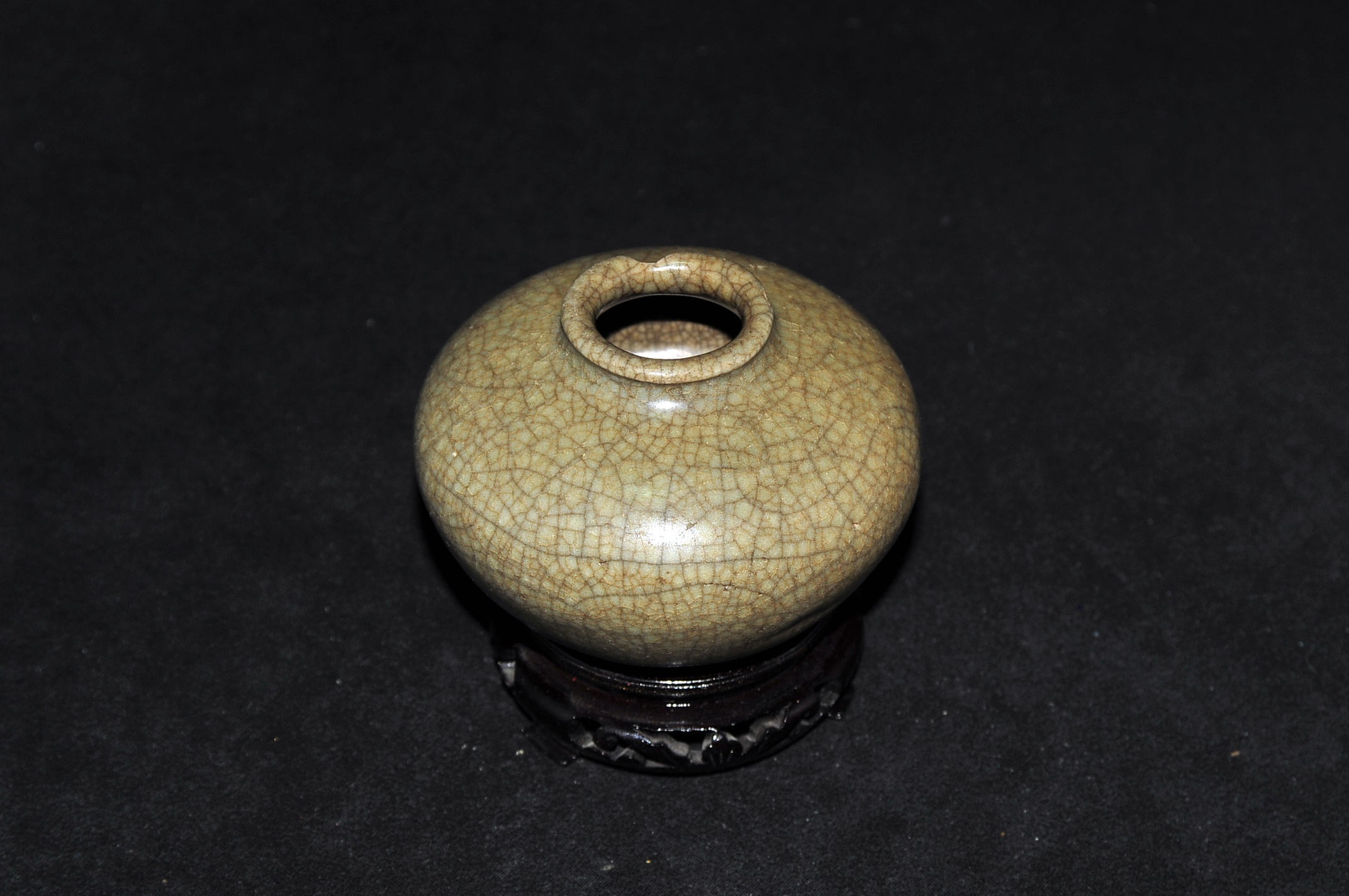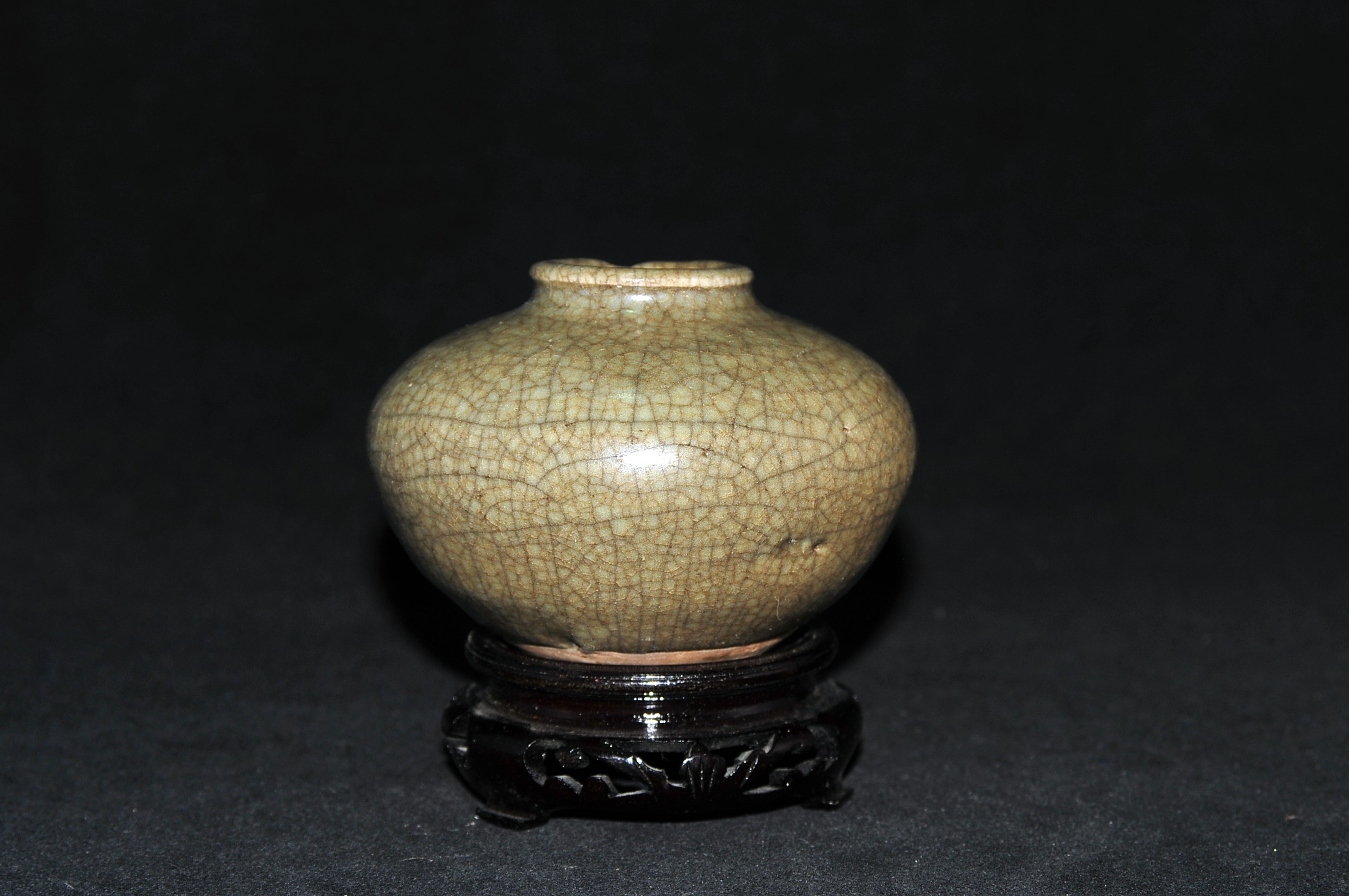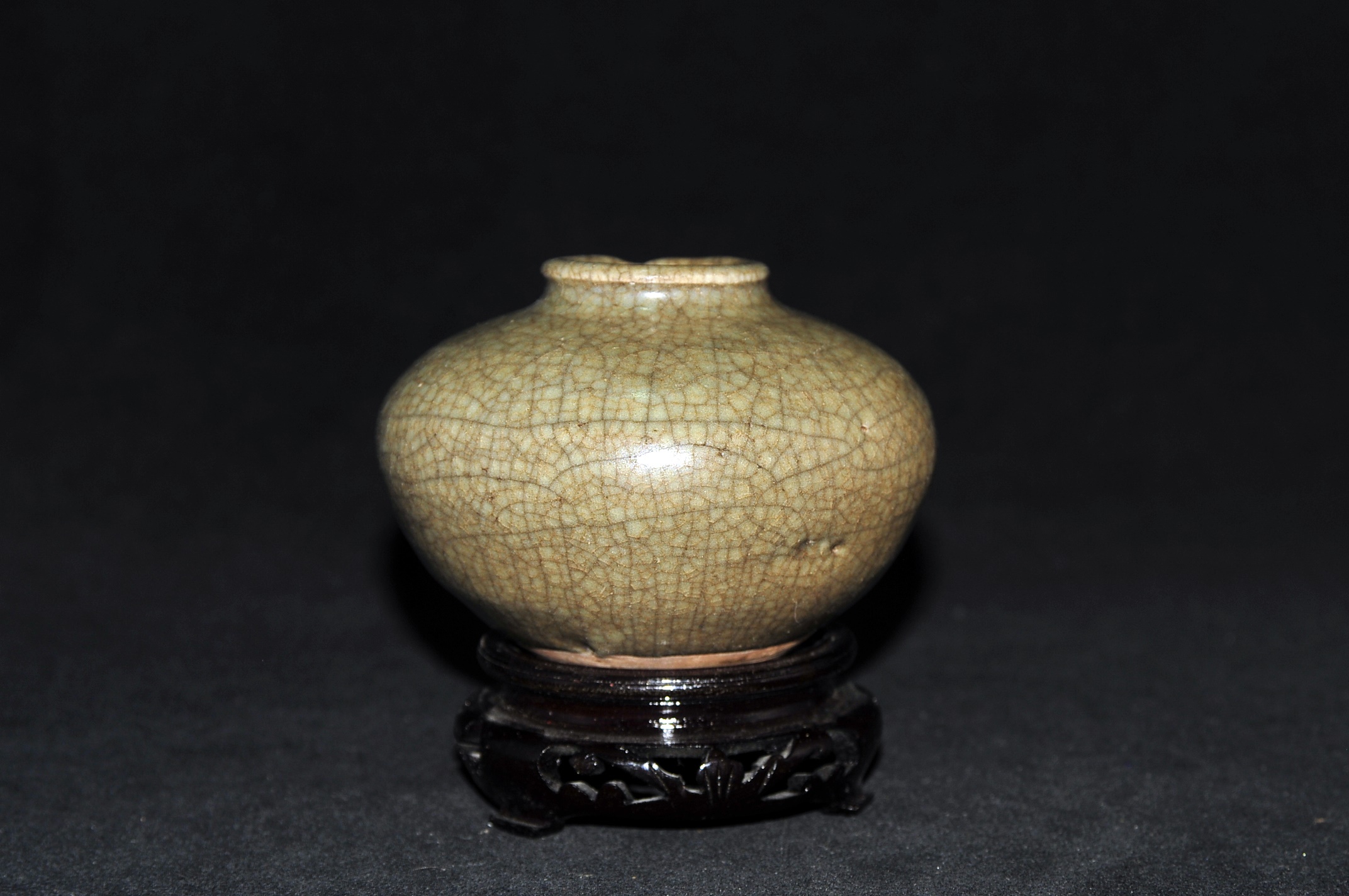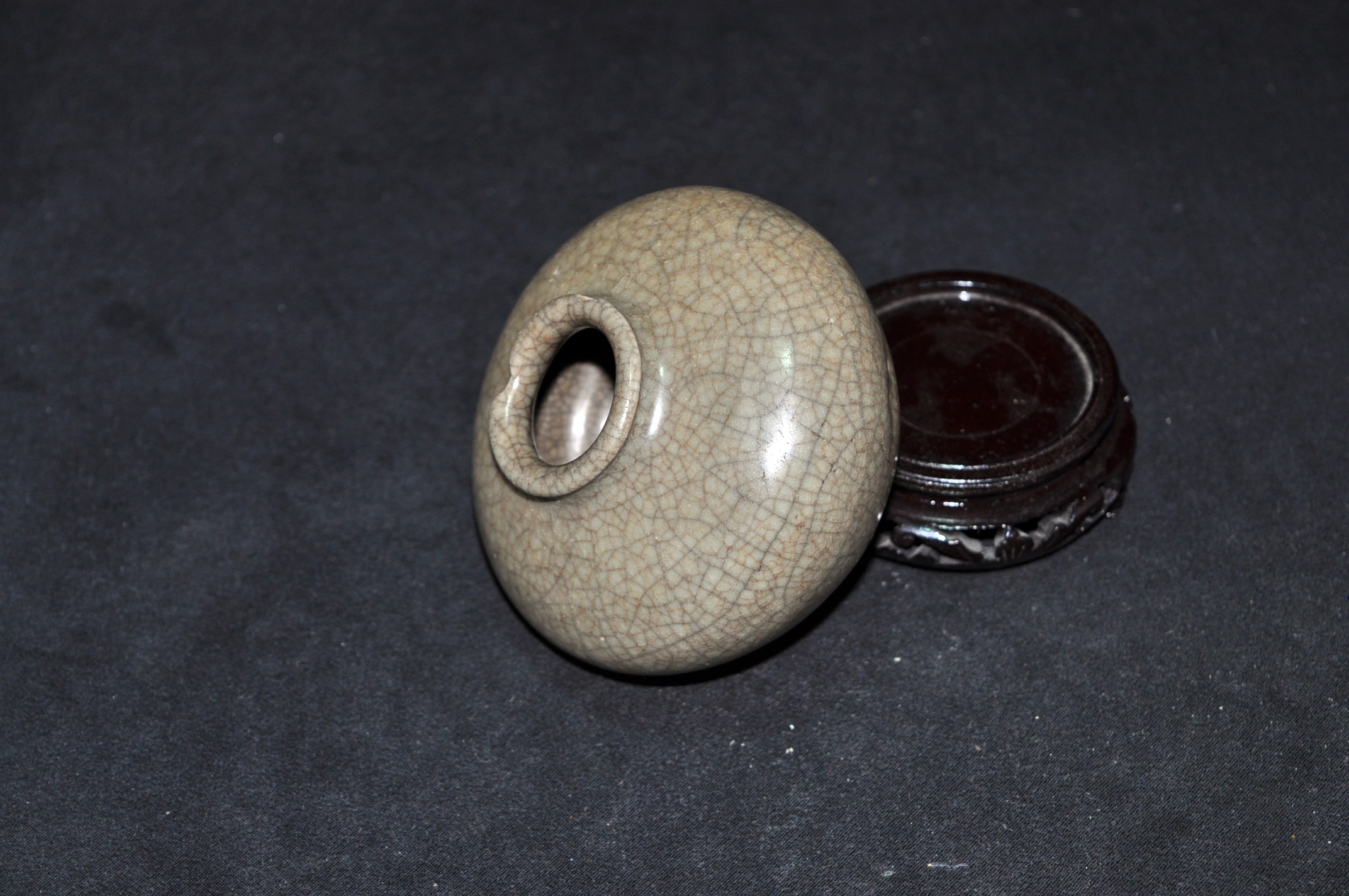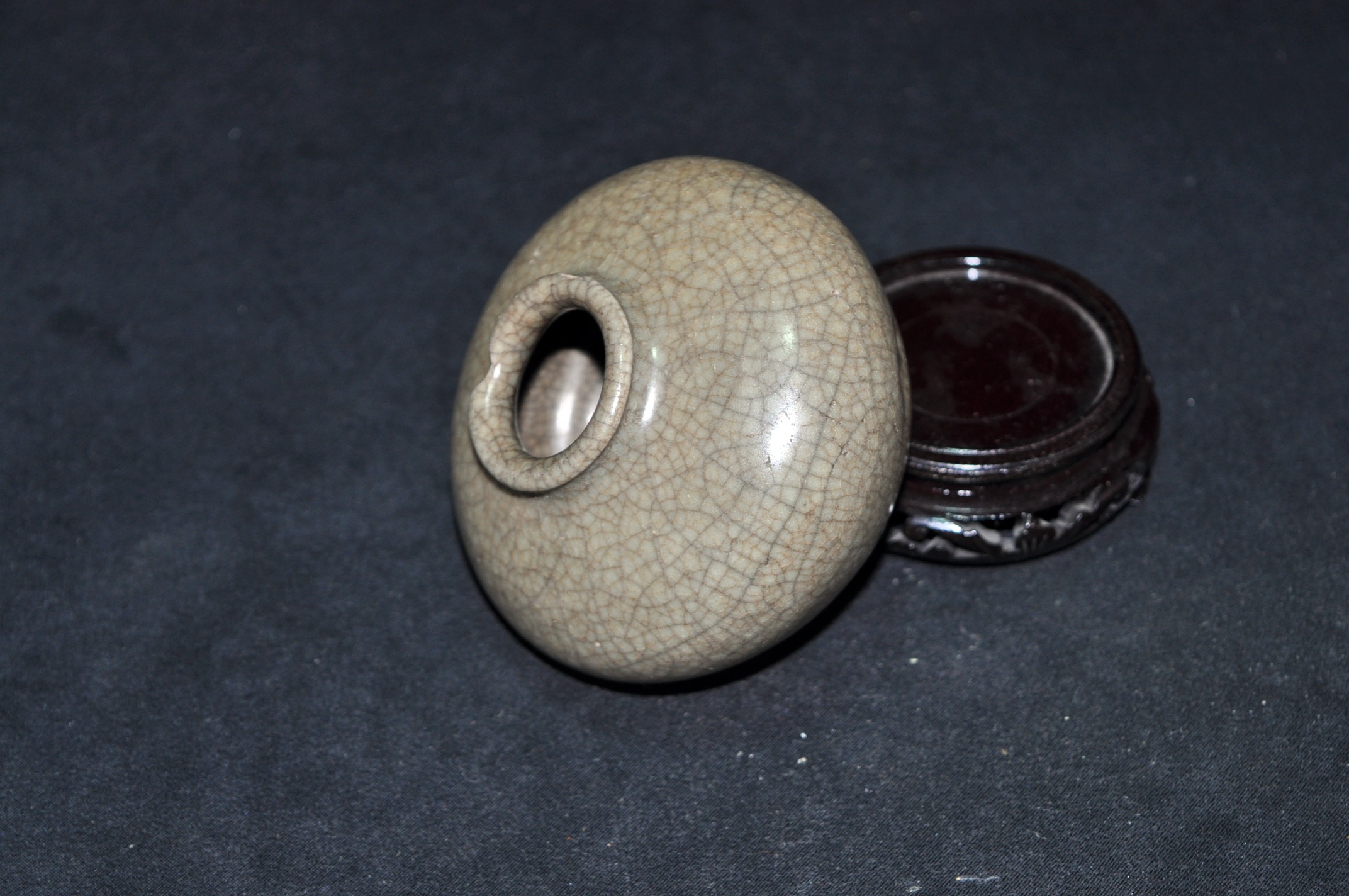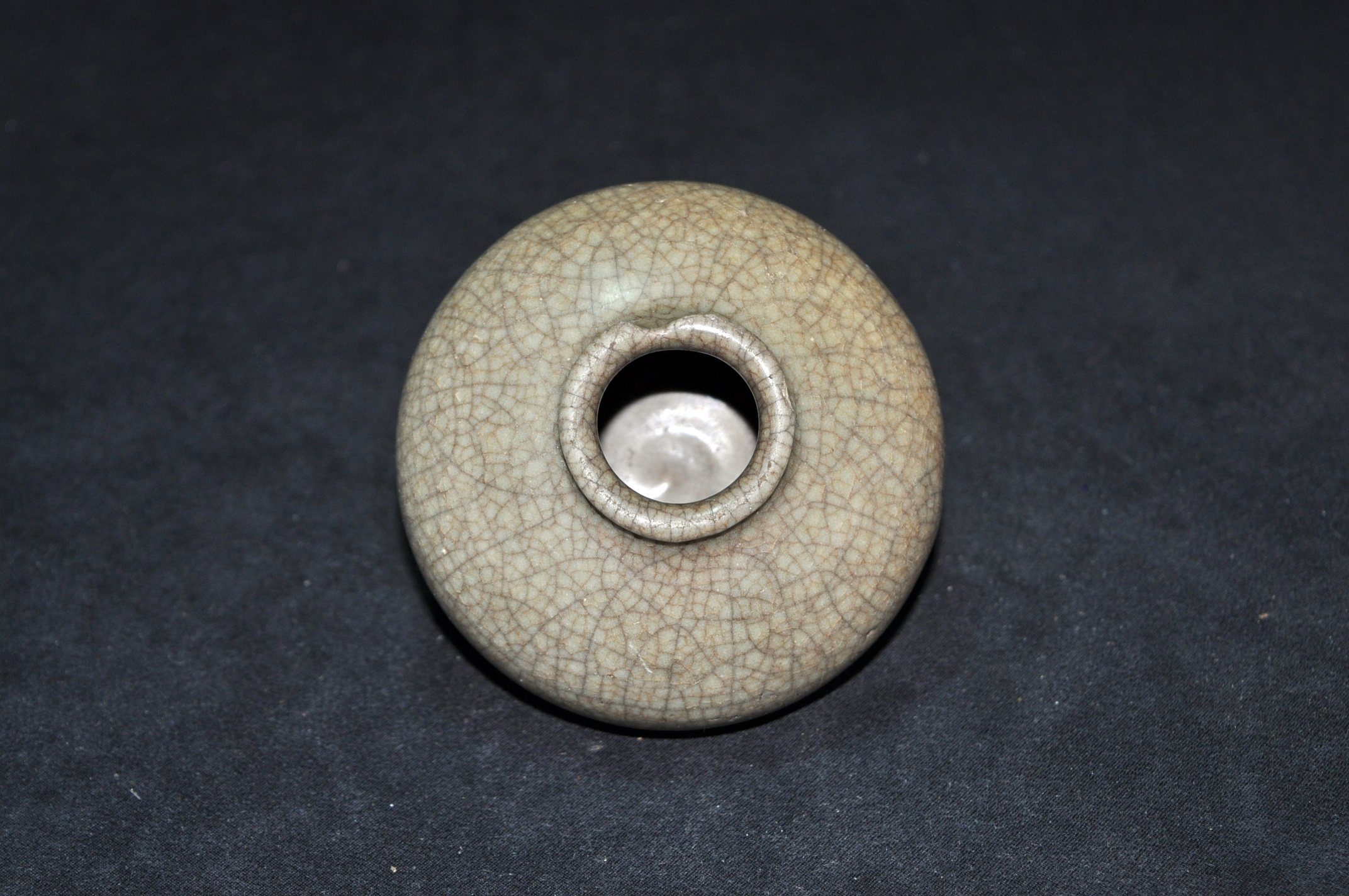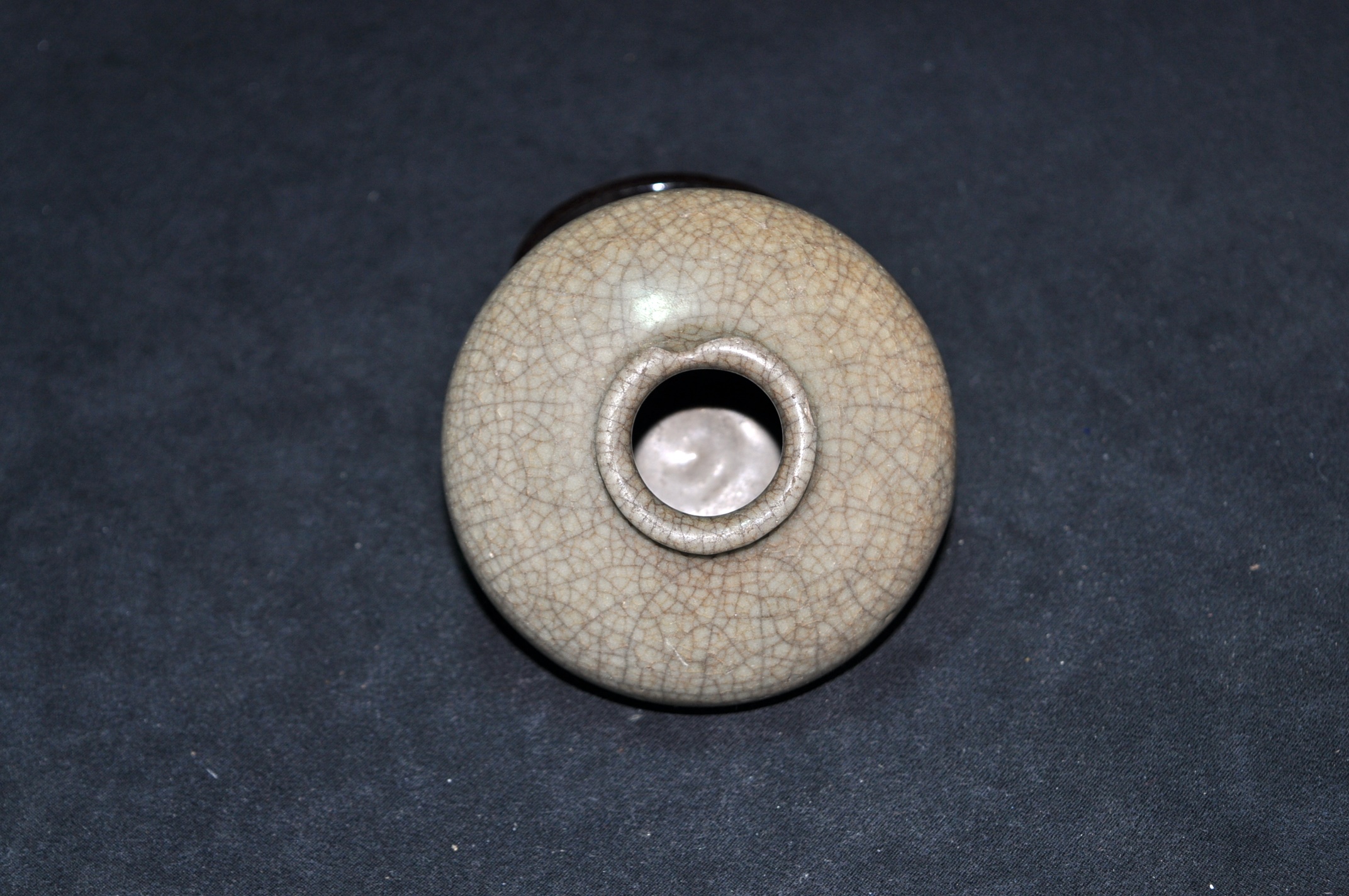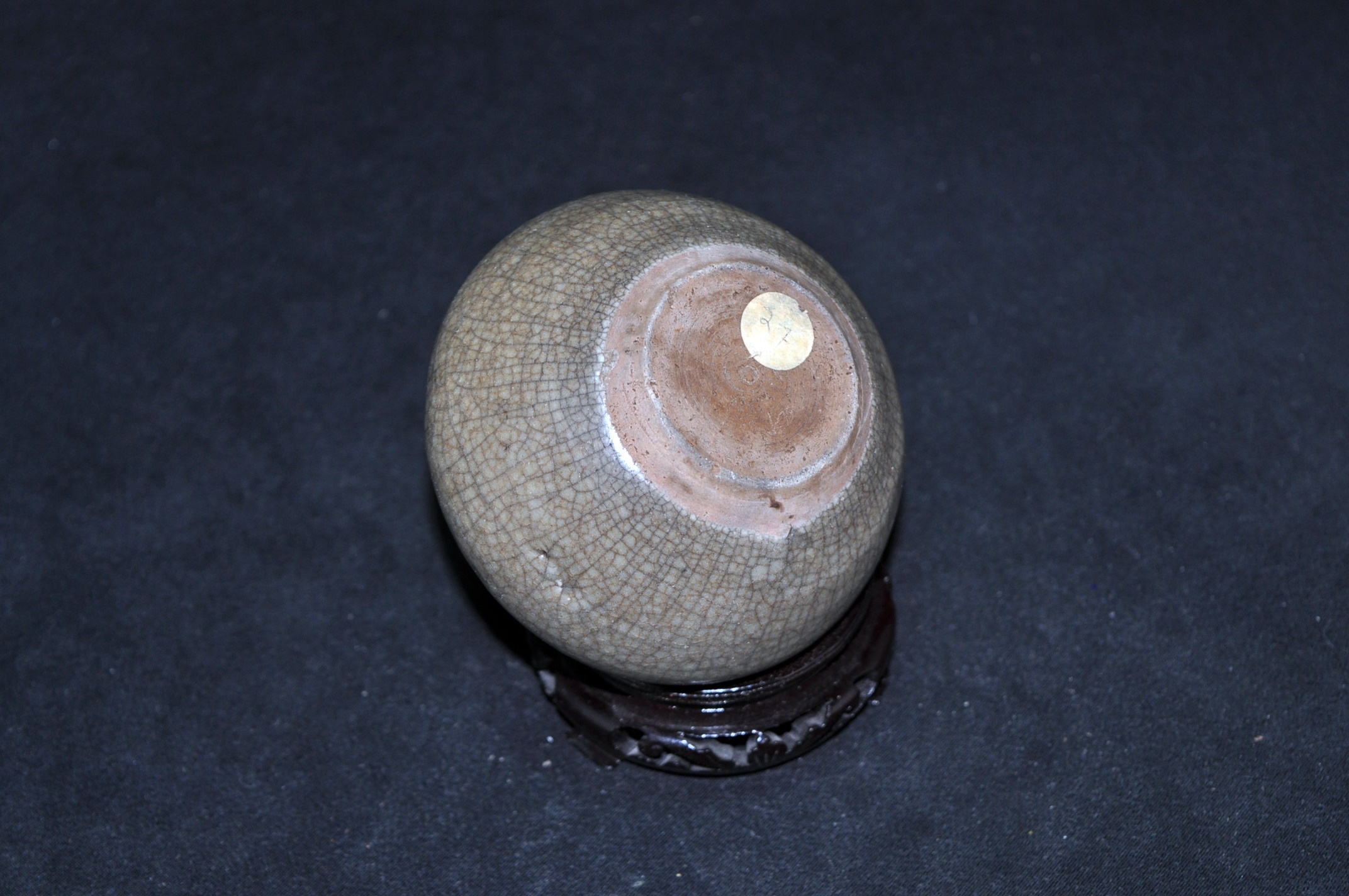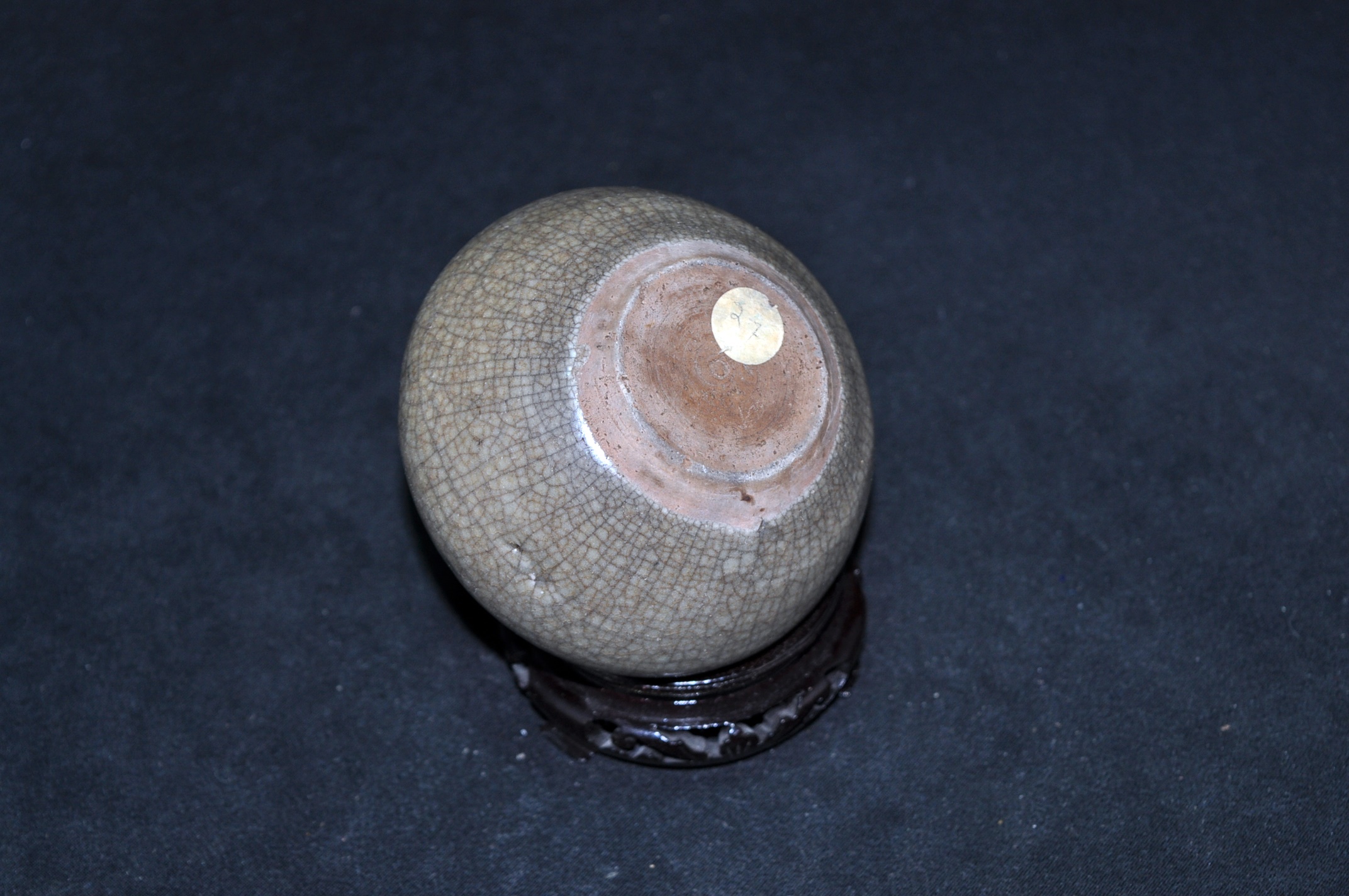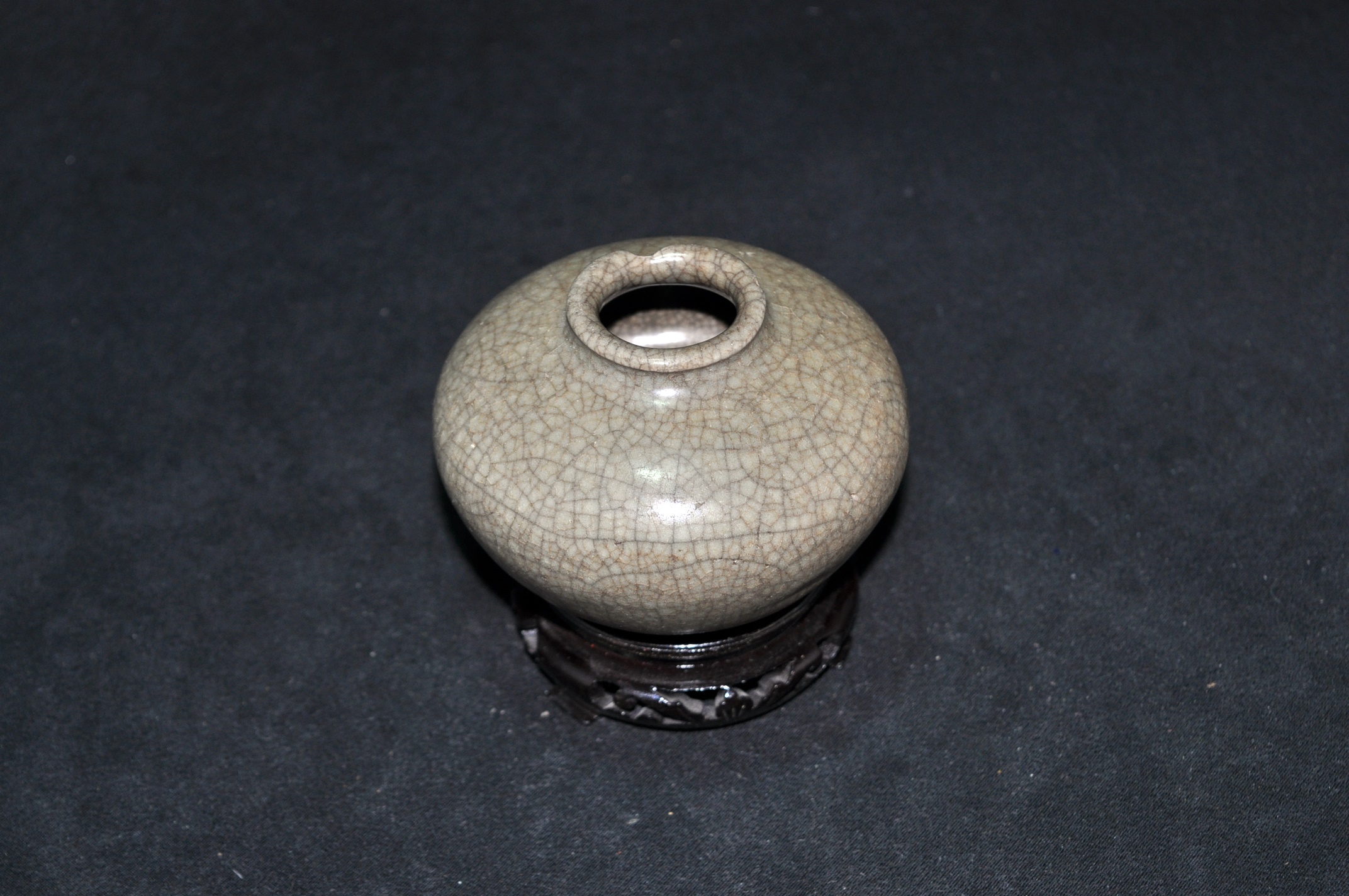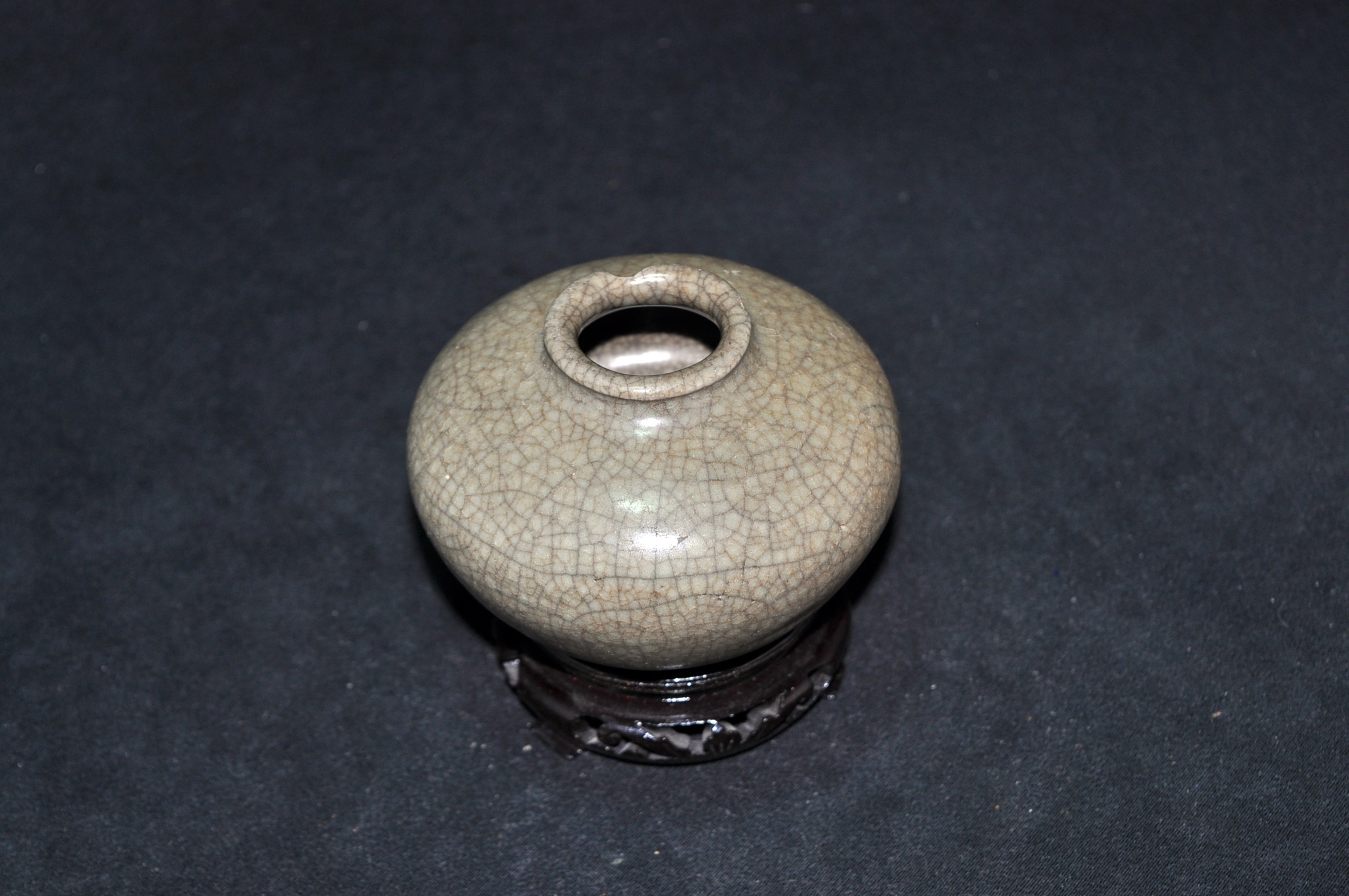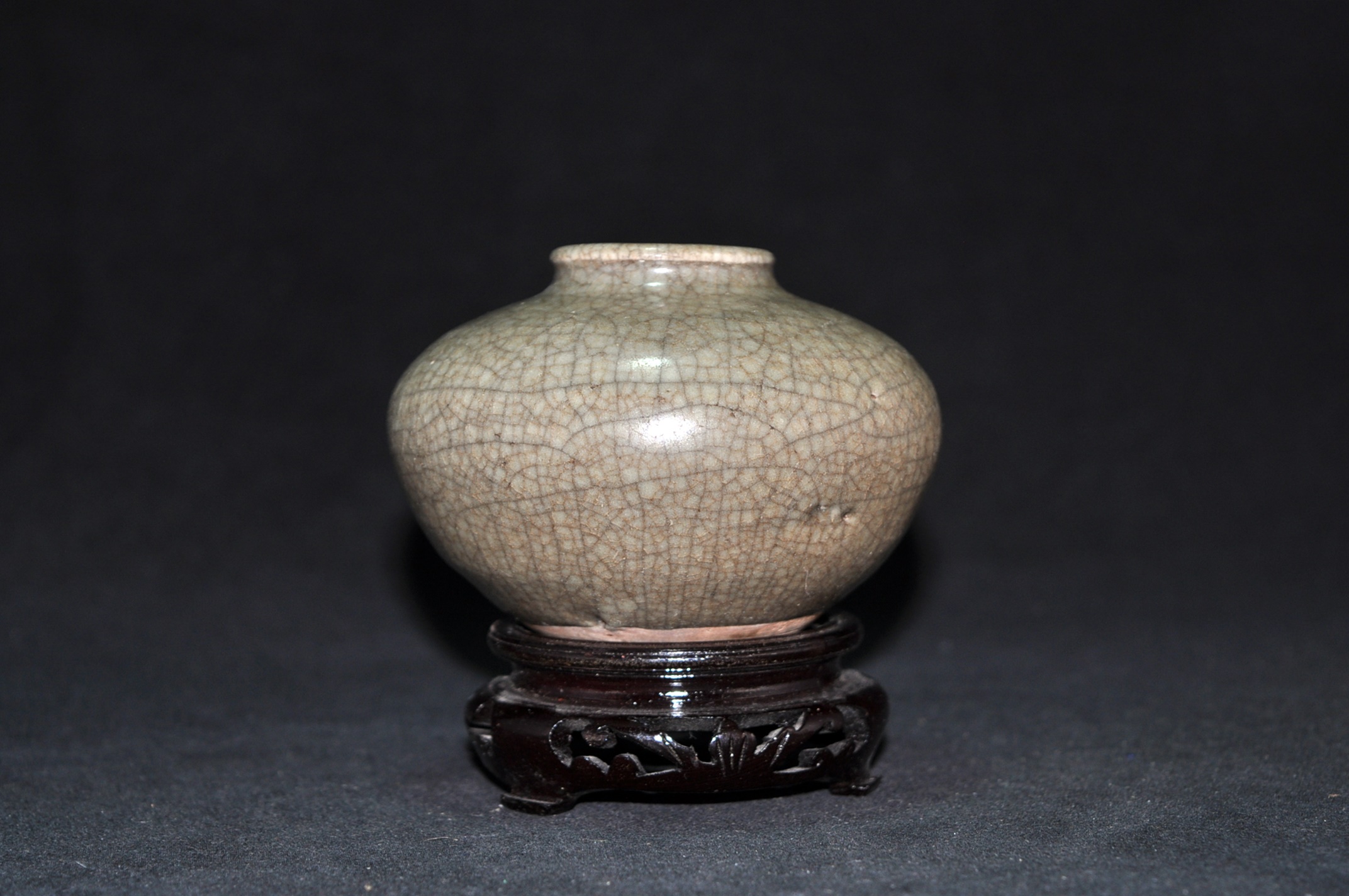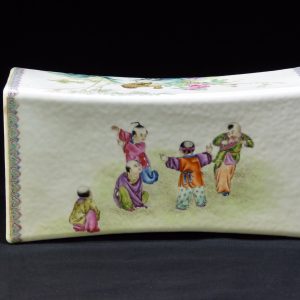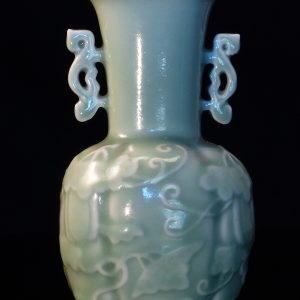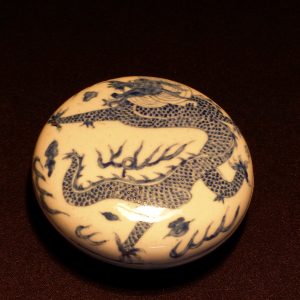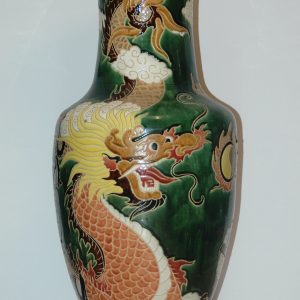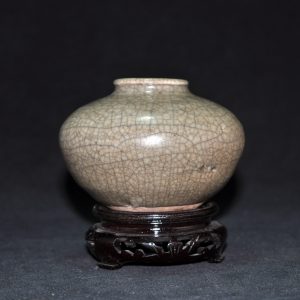Description
北宋 哥窑青釉水洗水盂
参考:佳士得
網上拍賣 17412
5 9月 2019
中國藝術: 包括ARNHOLD私人珍藏
拍品 170 明 仿哥釉三足洗
a_ge-type_lobed_tripod_washer_ming_dynasty
MING DYNASTY (1368-1644)
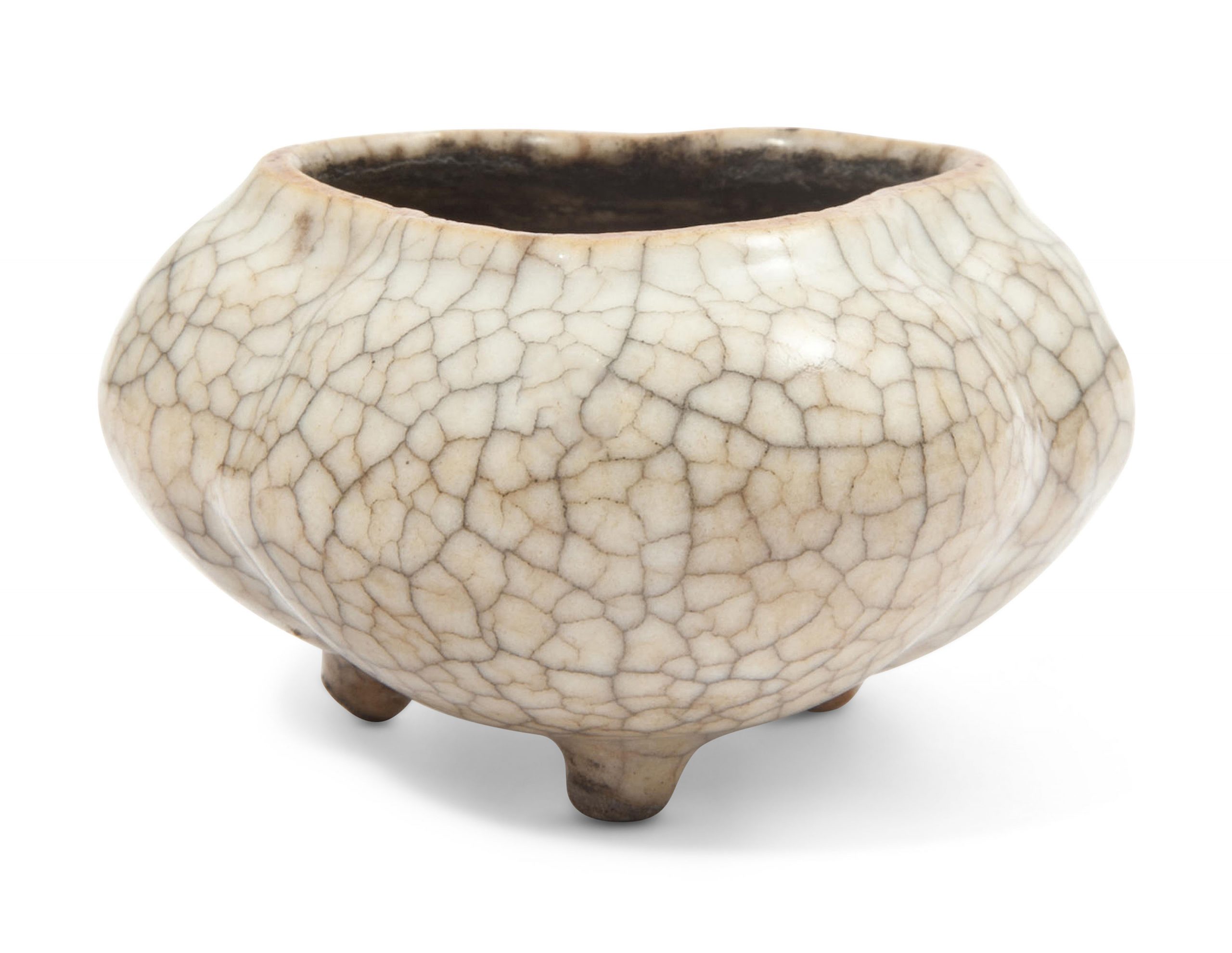
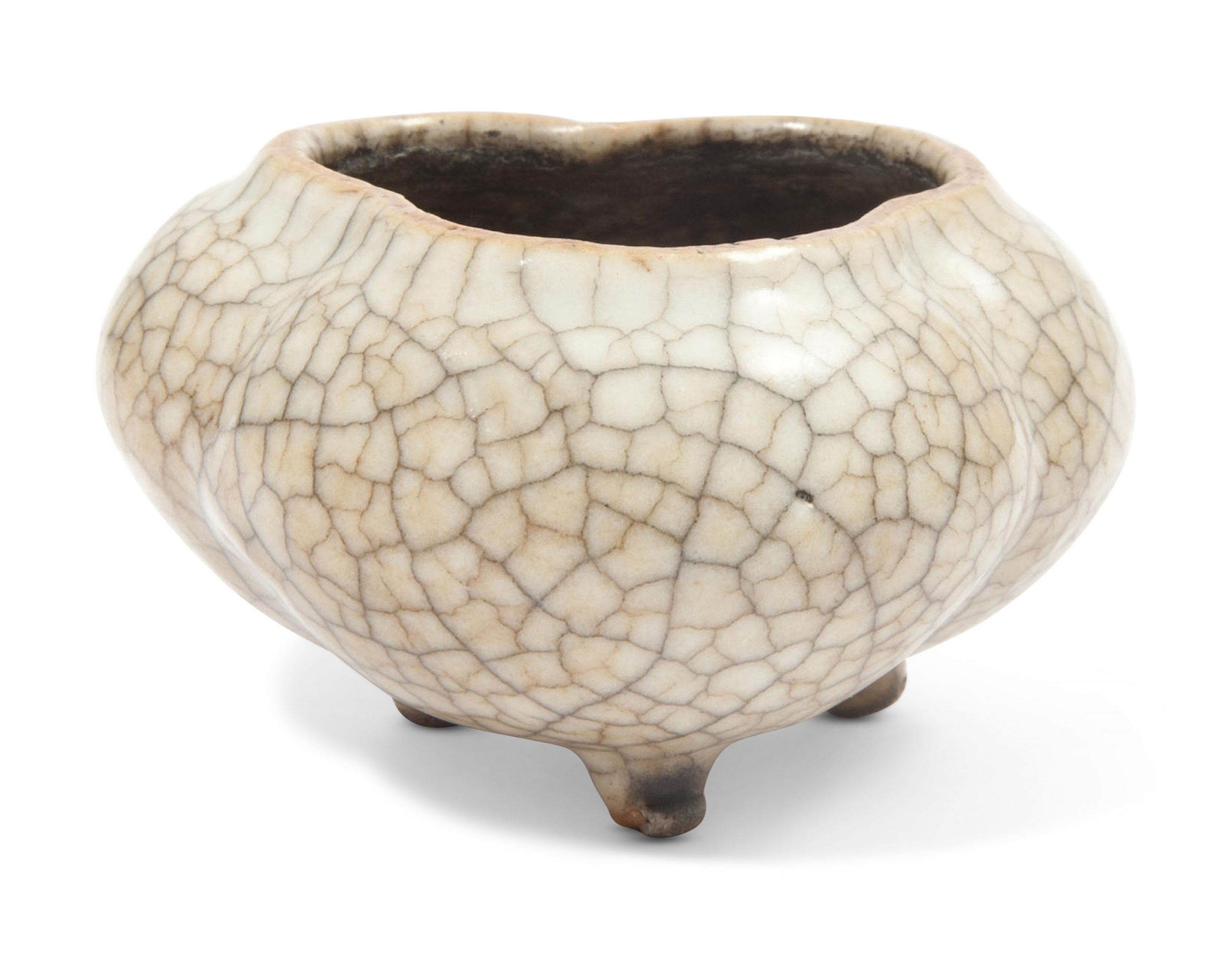
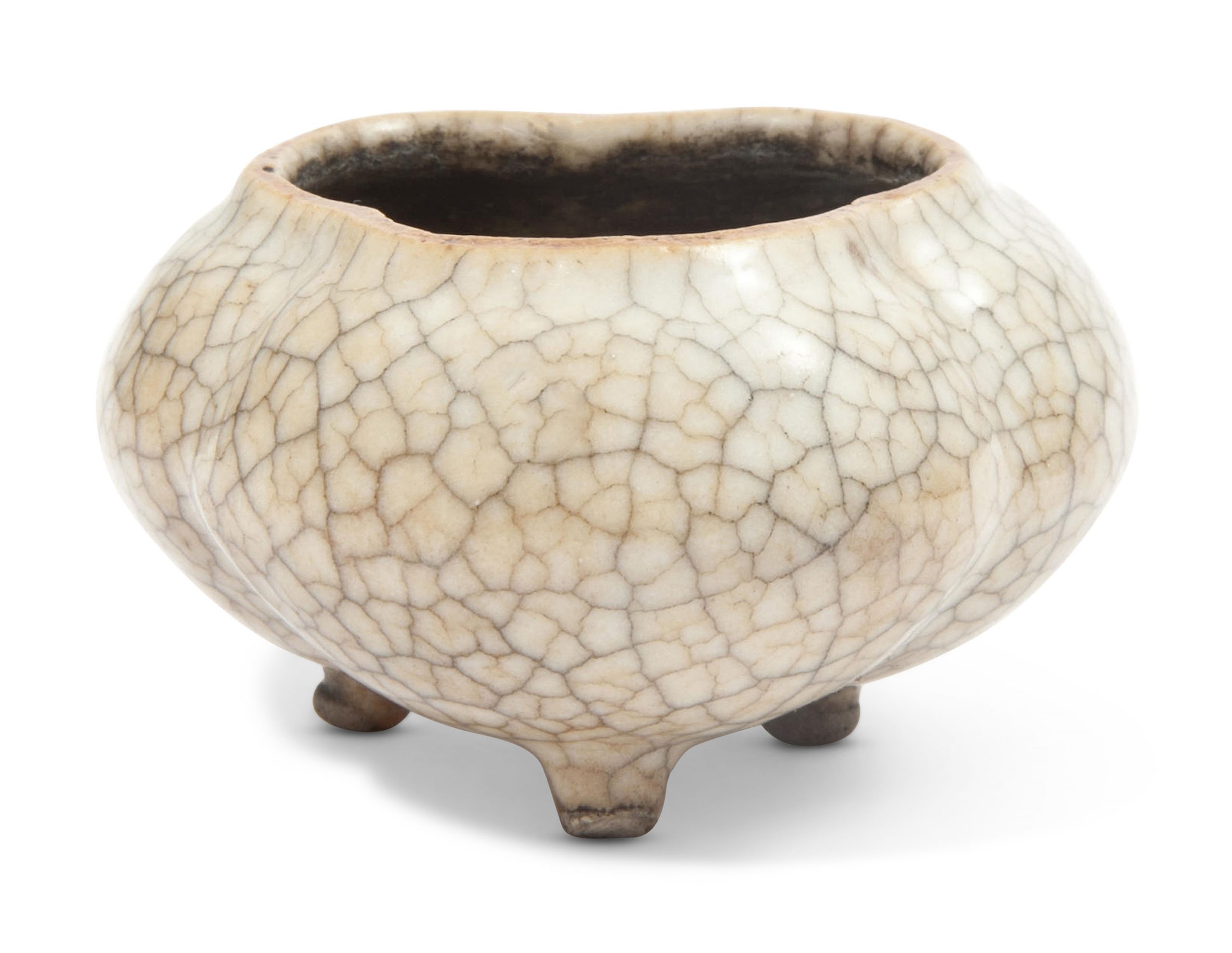
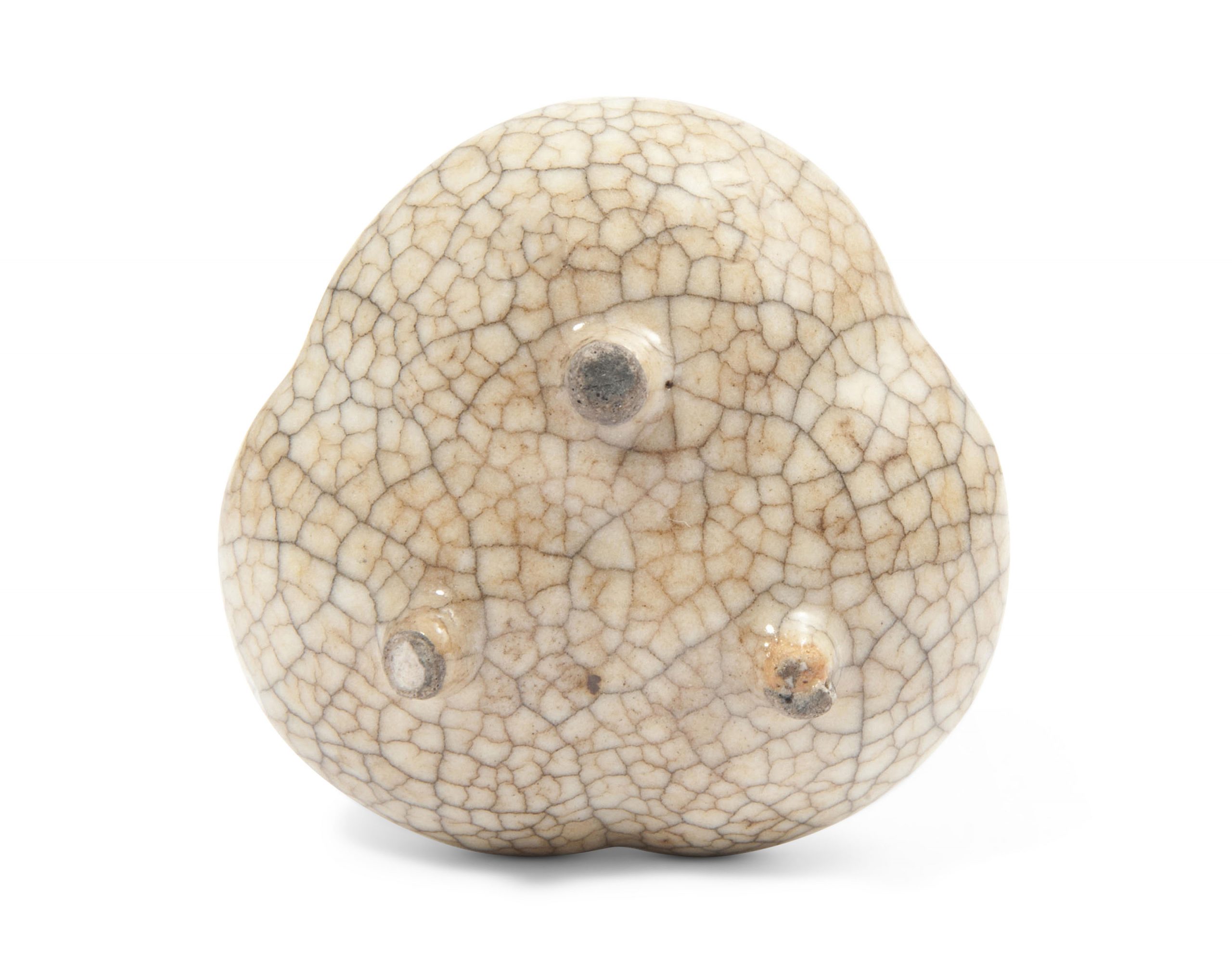
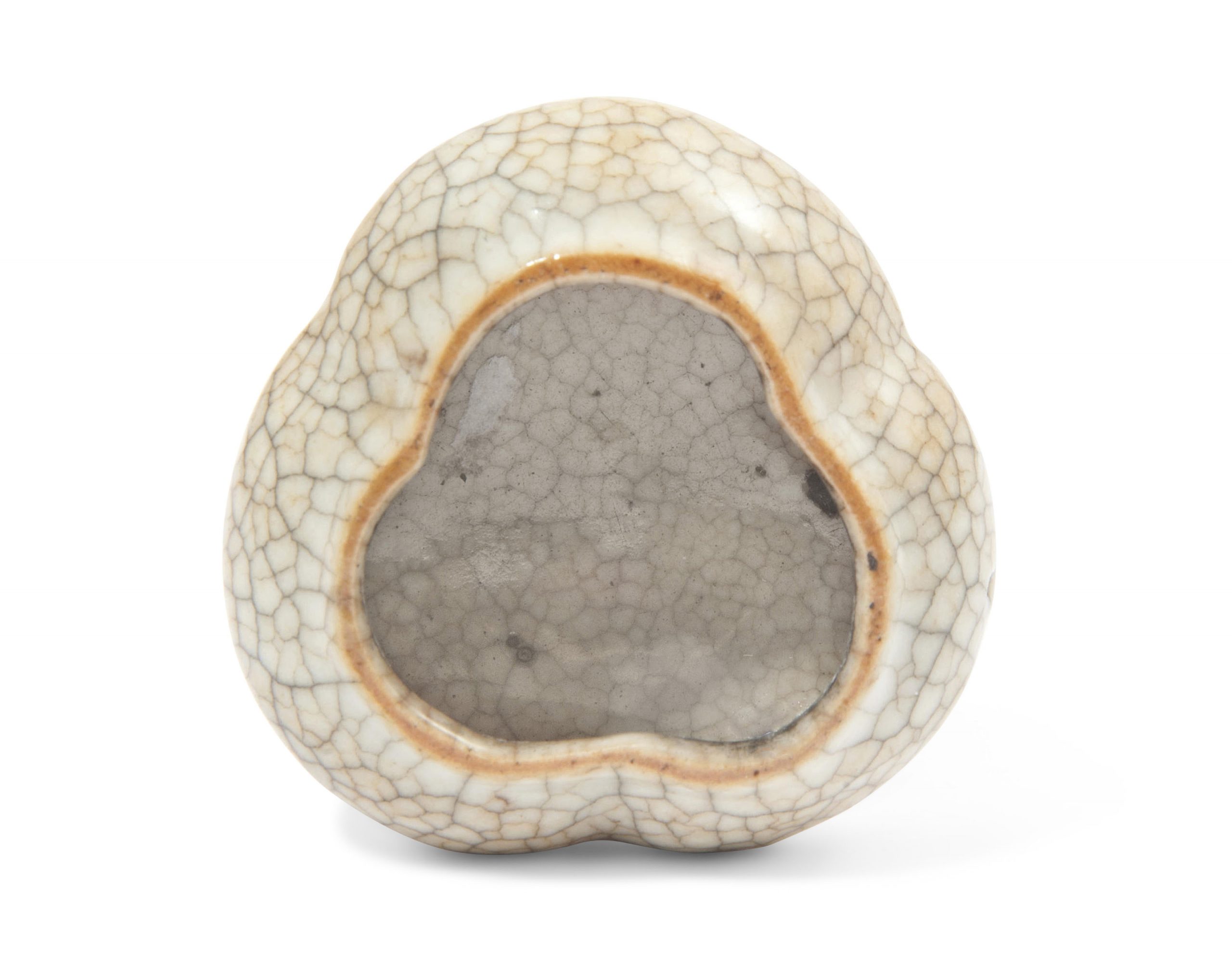
成交價 GBP 2,750
估價 GBP 2,000 – GBP 3,000
來源
蘇富比紐約2017年9月16日, 拍品1013
拍品賣家為: Christie Manson & Woods Ltd
状况报告
- 口沿有一个微小的磕痕。
- 内部侧面有一些黑色残留物。
参考:苏富比
中國藝術品
03 十二月 2015 • 香港
258 宋 月白釉水盂
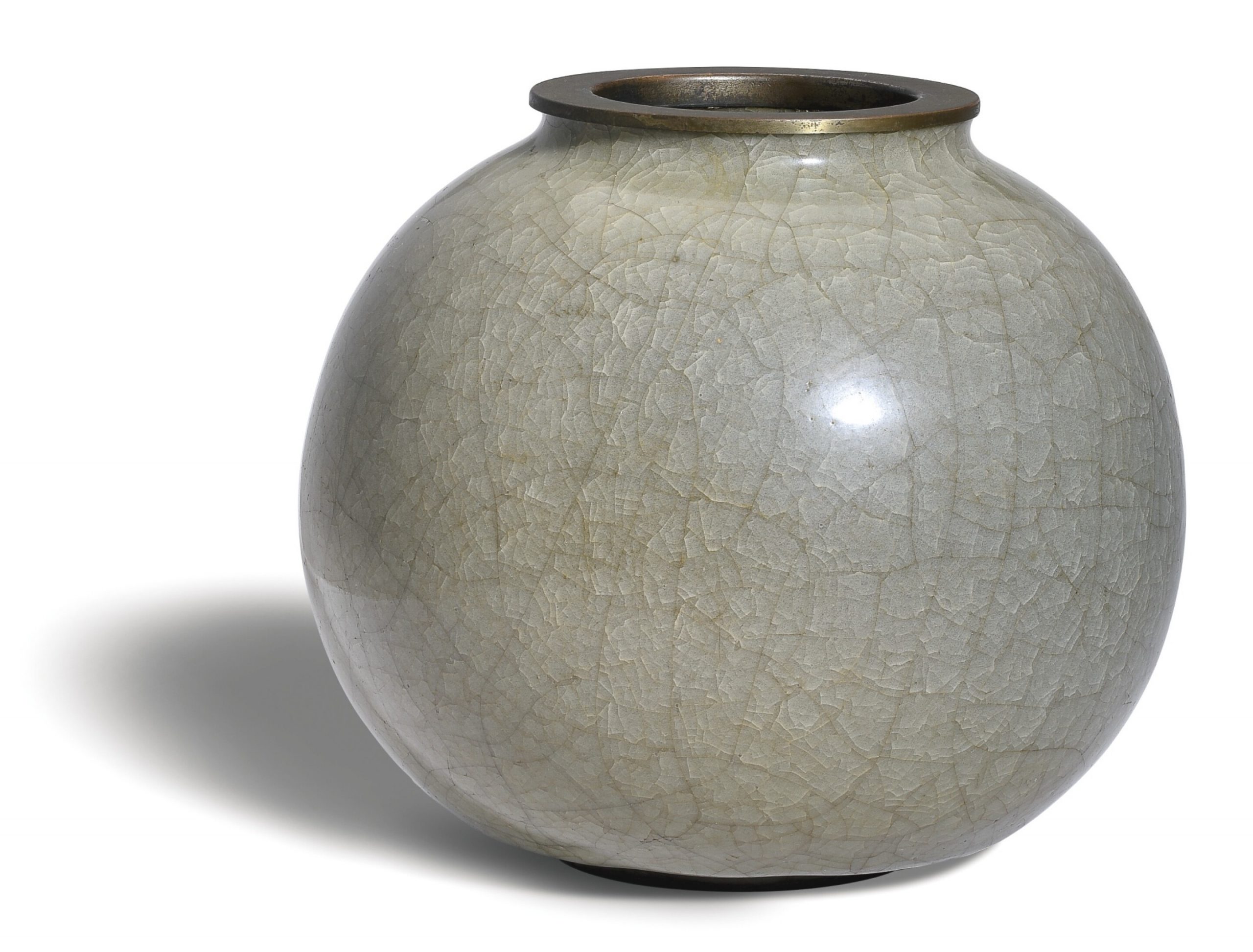
估價 50,000 – 70,000 HKD
已售出 1,750,000 HKD
描述
ceramic
寬 21 公分,8 1/4 英寸
possibly the lower section of a double gourd, the globular vessel applied overall with a beautiful ‘ice’-crackle glaze of rich moss-green colour, save for the unglazed footring revealing a lustrous black stoneware, the rim now set with a flat metal mount
拍品資料及來源
見一件南宋灰青葫蘆瓶,錄於《宋元陶瓷大全》,臺北,1993年,頁486。
參考:國立歷史博物館
朝代:南宋 品名:龍泉窯小盂

資料類型:瓷器
主題與關鍵字:弁遄G生活用器
描述:器型名稱:水盂
器型類別:盂
說明:光滑圓潤,宋代(西元960~1279)瓷器 ,菲律賓出土,丁念先 先生捐贈
格式:尺寸:口徑3.5 底徑3.5 高7
参考: 香港蘇富比
1995年秋季拍卖会 1995-10-31
中国陶瓷、工艺品及玉器雕刻
LOT号: 0353 明 哥窑瓜棱三足炉

尺寸 9.5cm
估价 HKD 15,000-20,000
成交价 流拍
参考:苏富比 848
A SMALL GUAN-TYPE OVOID JAR,
YUAN – EARLY MING DYNASTY

Estimate: 1,000 – 2,000 USD
LOT SOLD:12,500USD(31 bids, reserve met)
Description
A SMALL GUAN-TYPE OVOID JAR
YUAN – EARLY MING DYNASTY
元至明初 官窰式小罐
Height 2¾ in., 7 cm
Condition Report
Overall in good condition. Inherent patches of glaze loss and burst bubbles around base.
整體品相良好,除了底部些許窰燒瑕疵如剝釉及爆釉。
参考:苏富比
雅静清靈:清代御瓷私人珍藏
3118 清乾隆 仿哥釉雙耳罐 《大清乾隆年製》款
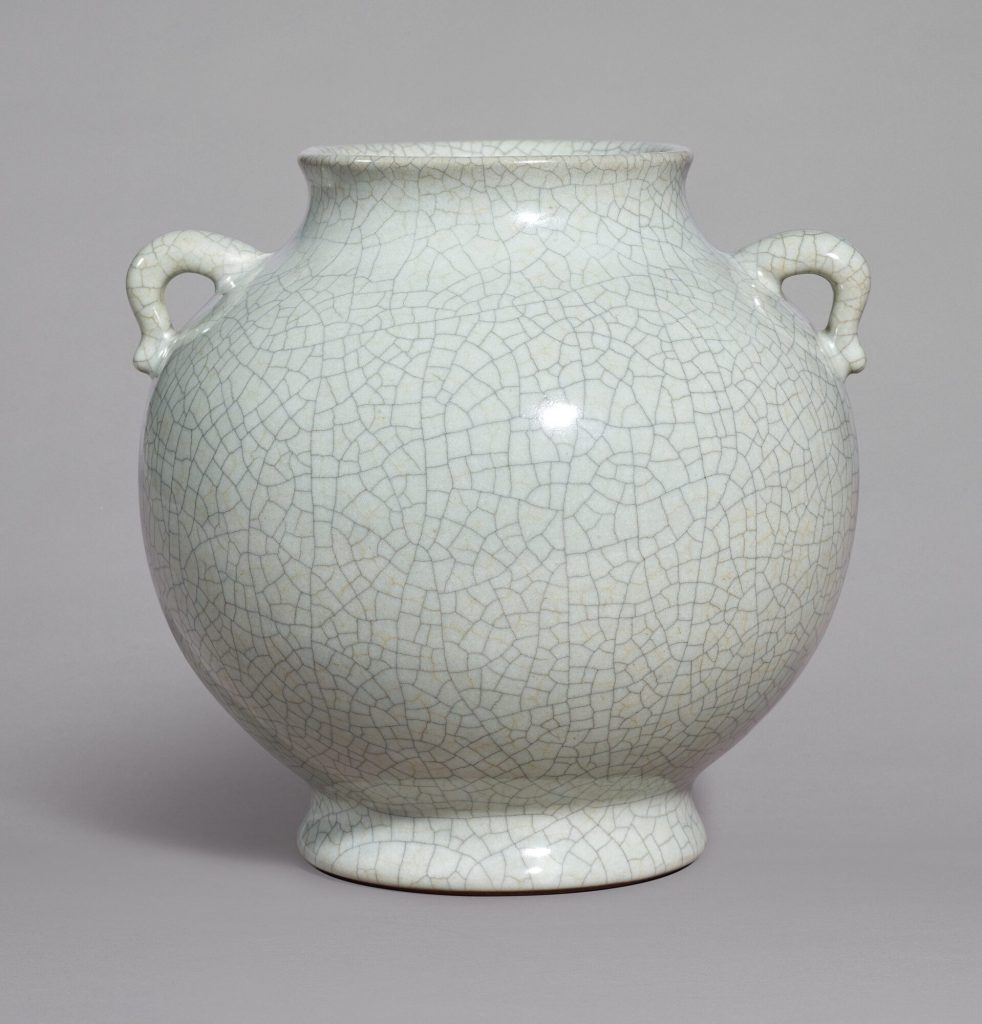


1,200,000 — 1,600,000港幣
拍品詳情
清乾隆 仿哥釉雙耳罐 《大清乾隆年製》款
寬 22 公分,8 5/8 英寸
狀況報告
整體品相良好,唯圈足有一約3公分處經修飾。
相關資料
本罐器形以高古青銅器為靈感,開片紋則明顯取材自深得雍正及其他清帝喜愛之宋官窰瓷。宋代瓷器上之開片紋,明清持續流行,兩朝均有仿之,此風至十八世紀尤盛。雍正、乾隆慕古好雅,同時積極推動景德鎮御窰技術發展,促進仿古釉瓷的燒造。釉面片紋,乃瓷器出窰冷卻時刻意調節窰内溫度所至,可成兩層裂紋,加上染色,敦實古樸。本罐釉面潤澤,開片均勻,器足醬色,摹擬宋釉鐵足,尤顯瓷匠造詣。
同器形並帶乾隆年款之開片紋罐甚爲罕見,據現時記載疑爲孤例。參考一尺寸較大之仿哥釉例,頸較長,飾獸面鋪首耳,乃飛鳥井家族舊藏,售於香港佳士得2007年5月29日,編號1528。
器形相同者,以窰變釉更為常見。比較一雍正帶款例,售於香港蘇富比1980年5月20日,編號125。另一例則售於倫敦蘇富比1996年12月17日,編號126。
本罐器形或仿東周青銅缶,如河南輝縣琉璃閣出土例,圖見蘇芳淑,《Eastern Zhou Ritual Bronzes from the Arthur M. Sackler Collections》,華盛頓,1995年,圖34.2。
雅静清靈:清代御瓷私人珍藏
2019年10月8日 | 上午 10:00 HKT
香港
参考:佳士得 拍賣 2580
重要中國瓷器及工藝精品 (1及2)
紐約|2012年9月13日 – 14日
拍品1523|VARIOUS PROPERTIES
清十八世紀 綠釉小瓶
18TH CENTURY
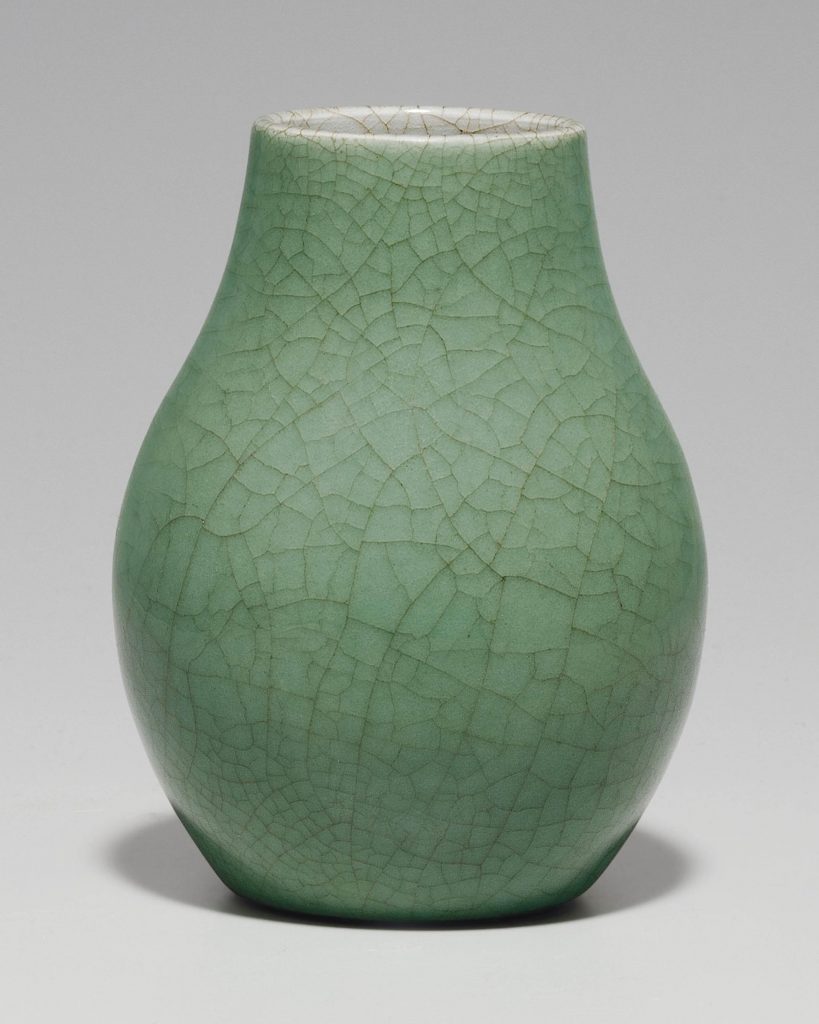
成交總額 USD 8,750
估價 USD 6,000 – USD 8,000
清十八世紀 綠釉小瓶
参考:佳士得拍賣 3720
重要中國瓷器及工藝精品
紐約|2015年3月15日 – 16日
拍品3243|PROPERTY FROM A DISTINGUISHED PRIVATE COLLECTION
南宋/元 哥窯水丞
SOUTHERN SONG-YUAN DYNASTY (1127-1368)
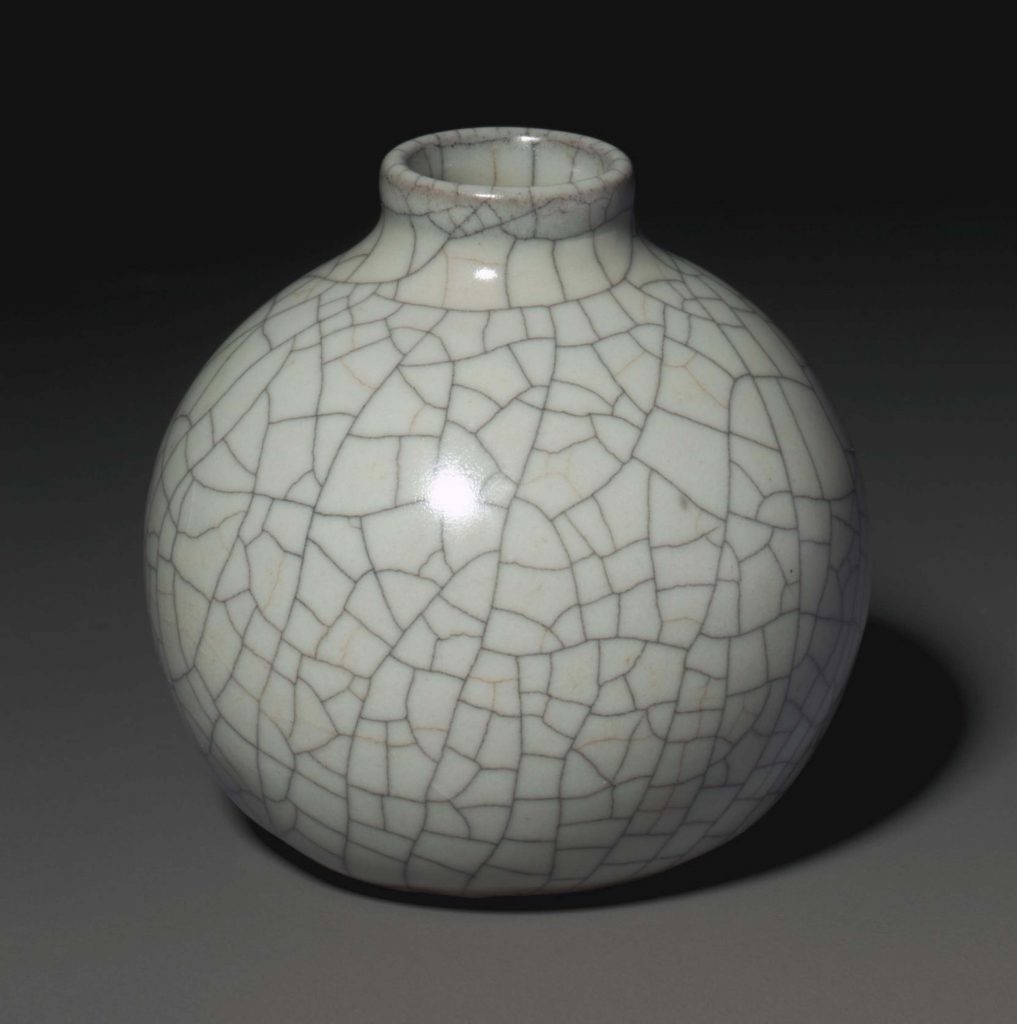
成交總額 USD 1,085,000
估價 USD 1,000,000 – USD 1,500,000
南宋/元 哥窯水丞
來源
Christie’s Hong Kong, 1 November 2004, lot 802.
文獻及展覽
文獻
Christie’s 20 Years in Hong Kong, 1986 – 2006, Chinese Ceramics and Works of Art Highlights, p. 31.
拍品專文
This water pot has an exceptionally well-potted spherical form. Small compressed globular water pots with celadon glazes were made in Zhejiang province as early as the Southern Dynasties period (AD 420-589). One such vessel, excavated from a 5th century tomb in Yongjia county and now in the Wenzhou Museum, is illustrated in Complete Collection of Ceramic Art Unearthed in China, vol. 9, Zhejiang, Beijing, 2008, p. 87. Similar compressed globular water pots, with or without three small feet, were also made at the Ou kilns and the Yue ware kilns in the Tang dynasty. Examples from the Wenzhou Museum and the Cixi Museum are illustrated ibid, pp. 126 and 127 respectively. However, in the Five Dynasties period well-potted spherical water pots can be found amongst vessels from prestigious kilns which found favour with the imperial court. A mise celadon water pot of this spherical form, and of very similar size to the current Ge ware vessel, was excavated in Lin’an county in 1996 from the Kangling Mausoleum (dated AD 939), illustrated ibid., p. 143. A fine 10th-century spherical white-glazed water pot with incised lotus decoration, slightly smaller than the current Ge ware vessel, is in the collection of the Tokyo National Museum. This white water pot, which is illustrated in Sekai toji zenshu, vol. 11, Sui Tang, Tokyo, 1976, pp. 115-6, pls. 92-3, is inscribed on the base with the characters xin guan (new official). Although the Tokyo water pot has no neck or raised mouth rim, a small Ding ware spherical water pot (7.5 cm high) with a very short neck was excavated in 1969 from the foundations of the Jingzhongyuan Temple pagoda, dated AD 995, illustrated by the Idemitsu Museum of Arts in Treasures from the Underground Palaces – Excavated Treasures from Northern Song Pagodas, Dingzhou, Hebei Province, China, Tokyo, 1997, no. 90. A larger spherical Ding ware water pot with longer neck and thickened rim, also from Jingzhongyuan Temple pagoda, is illustrated by Liu Tao in Song Liao Jin jinian ciqi, Beijing, 2004, p. 5, fig. 1-29. Thus, by the early Northern Song dynasty, late 10th century, the spherical form for small water pots was already established as desirable amongst the Chinese elite.
A Guan-type water pot of similar size to the current vessel, with a spherical body, but standing on three short, splayed legs, is illustrated in Mayuyama Seventy Years, vol. 1, Tokyo, 1976, p. 161, no. 467. A Guan or Ge ware spherical water pot, also of similar size to the current vessel, was sold by Christie’s Hong Kong on 13 January 1987, lot 570. A water pot with Guan-type glaze, of slightly smaller size compared to the current vessel, and of compressed globular form, is illustrated in Chinese Ceramics, Song and Yuan Dynasty, Taipei, 1988, p. 515. A slightly larger 13th century spherical celadon-glazed water pot from the Longquan kilns, with floral surface decoration, is in the collection of Sir Percival David (illustrated in Illustrated Catalogue of Celadon Wares in the Percival David Foundation of Chinese Art, revised edition, 1997, pp. 29-30, no. 232), and was exhibited in Arts de la Chine Ancienne at the Musée de l’Orangerie, Paris, in 1937, exhibit no. 447. Nevertheless, few examples of similar vessels from any of the classic kilns of the 10th-13th century have survived into the present day.
Since the Ming dynasty, Ge wares have been regarded as one of the ‘Five Great Wares of the Song Dynasty’, along with Ru ware, Ding ware, Jun ware, and Guan ware. These wares remain the most revered wares of the Song dynasty (AD 960-1279), a period which Chinese connoisseurs have traditionally admired above all others for the refined beauty of its ceramics – typified by vessels with elegant forms, enhanced with subtly colored monochrome glazes. A variety of such wares were appreciated by members of the Song elite and the imperial court, as well as by later collectors, but texts tell us that these five types were held in particular esteem. Ge ware and Guan ware have been the subjects of extensive research by Chinese scholars and those from other countries in recent years, and they continue to be at the forefront of interest amongst scholars and collectors alike. Both Guan ware and Ge ware are characterized by subtly-colored glazes which were deliberately crackled to achieve a fine network of lines over the surface of the vessel. One of the reasons that these crackle lines were admired was that they were reminiscent of the fissures in jade, the most prized of all natural materials.
The high regard in which such pieces were held by the great Qing dynasty imperial collector, the Qianlong Emperor (1736-1795), for example, is demonstrated by the fact that Ge ware dishes appear in several informal portraits of the emperor. One such portrait is the famous painting entitled ‘One or Two?’, of which there are three versions in the Palace Museum, Beijing. One of these is illustrated in the catalogue of the exhibition, The Qianlong Emperor – Treasures from the Forbidden City, at the National Museums of Scotland, Edinburgh, 2002, p. 112, no. 59. The Qianlong emperor is shown seated on a day-bed in front of a screen on which is hung a portrait of himself, and surrounded by precious objects from his famous collection of antiques. One of these is a small crackled dish, which appears to be Ge ware. The admiration of the Qianlong Emperor for Ge wares can also be seen in the inscriptions that he applied to pieces in his collection. A recent exhibition at the National Palace Museum, Taipei, included eight Ge wares bearing Qianlong inscriptions (illustrated in Obtaining Refined Enjoyment: The Qianlong Emperor’s Taste in Ceramics, Taipei, 2012, nos. 35-7, 40-1, 43, 45, and 93). The same exhibition displayed a page from Qianlong’s hand-painted album Precious Ceramics of Assembled Beauty, which showed a Ge ware dish along with a discussion of the piece and various imperial seals (illustrated ibid., p. 203).
The Palace Museum, Beijing, has in its collection a censer, identified as Ge ware, which bears a Qianlong inscription (illustrated in The Complete Collection of Treasures of the Palace Museum – 33 – Porcelain of the Song Dynasty (II), Hong Kong, 1996, no. 51). The popularity of Ge and Ge-type wares at the courts of the Qing emperors is emphasised by the number of such pieces from the Qing Court Collection which are preserved in the Palace Museum, Beijing. Some 40 examples are published in Porcelain of the Song Dynasty (II), op. cit.
Examination of the Qianlong inscriptions highlights the subject on which there has been considerable debate among scholars and connoisseurs – the difficulty of determining whether a particular piece should be described as Guan ware or Ge ware. Certainly to judge from the Qianlong emperor’s inscriptions, he was inconsistent in his attributions. Traditionally it is said that Ge ware acquired its name from the Chinese term gege, meaning elder brother, since it was believed to have been made by the elder of the two Zhang brothers. Distinguishing between Ge and Guan ware is not greatly aided by the historical texts, which merely say that they looked similar to one another. A symposium held by the Shanghai Museum in October 1992 brought together all the leading Song ceramic scholars from China and abroad to discuss Ge ware and the ways to distinguish it from Guan ware. However, the debate regarding exact period of production and kiln site still rages. In light of the excavations carried out at the Xiuneisi kiln at Laohudong, some Chinese archaeologists now suggest that, like Guan ware, these beautiful and refined Ge wares may have been made at kilns just outside the walls of the Southern Song palace at Hangzhou, while others suggest that they may have been made at kilns nearer to the centre of Longquan production. Undoubtedly Ge wares, like the current water pot, display all the qualities that might be expected of vessels intended for imperial appreciation.
Rosemary Scott
International Academic Director, Asian Art
編製圖錄及詳情
拍品前備註
PROPERTY FROM A DISTINGUISHED PRIVATE COLLECTION
参考: 佳士得 拍賣 15488
中國瓷器及工藝精品
倫敦|2018年11月6日
拍品149
明 仿官釉八棱葵瓣洗
MING DYNASTY (1368-1644)
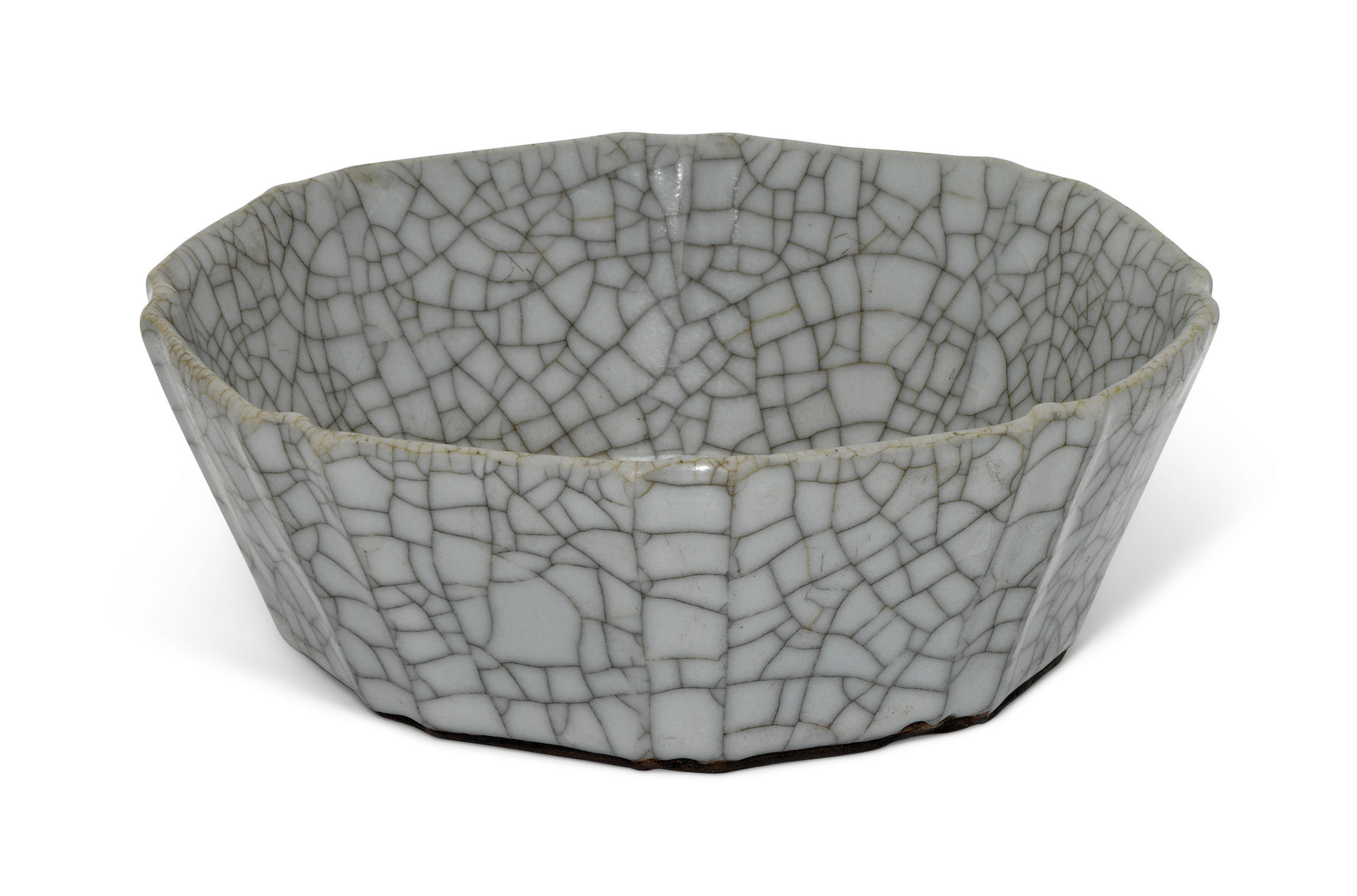
明 仿官釉八棱葵瓣洗
成交總額 GBP 16,250
估價 GBP 8,000 – GBP 12,000
明 仿官釉八棱葵瓣洗
5 ¾ in. (14.5 cm.) diam.
参考:纽约大都会博物馆
宋 龙泉窑 水盂
Jar, Pottery (Longquan ware), China

China, Song dynasty (960–1279)
Pottery (Longquan ware); 纽约大都会博物馆 宋 龙泉窑 水盂 Jar, Pottery (Longquan ware), China

China, Song dynasty (960–1279)
Pottery (Longquan ware); 纽约大都会博物馆 宋 龙泉窑 水盂 Jar, Pottery (Longquan ware), China
Object Details
Period:Song dynasty (960–1279)
Culture:China
Medium:Pottery (Longquan ware)
Dimensions:H. 2 3/8 in. (6 cm); W. 4 3/4 in. (12.1 cm)
Classification:Ceramics
Credit Line:Rogers Fund, 1917
Accession Number:17.118.29
Provenance
[ Unidentified dealer, Shanghai]
Timeline of Art History
Timelines
Central and North Asia, 1000-1400 A.D.
Central and North Asia, 500-1000 A.D.
China, 1000-1400 A.D.
China, 500-1000 A.D.
参考:纽约大都会博物馆
金元 钧釉 水盂太白尊
Jar, Jun ware, Chinese ,
Jin/Yuan Dynasty, Stoneware with splashed blue glaze., ca. 13th century
Chinese


Object Details
Artist:Chinese , Jin/Yuan Dynasty
Date:ca. 13th century
Culture:Chinese
Medium:Stoneware with splashed blue glaze.
Dimensions:Height 3 9/16 in. (9 cm.)
Classification:Ceramics
Credit Line: Robert Lehman Collection, 1975
Accession Number:1975.1.1666
Catalogue Entry
This rather thickly potted jar of squat, truncated-pear shape is covered inside and out with a heavily crazed and pitted purple- and crimson-splashed grayish blue glaze. The glaze ends in an uneven line on the exterior of the foot; the base is glazed as well. The body is fine-grained and burned buff. Two long cracks have been repaired with gold. In all likelihood, vessels of this shape were originally equipped with covers. A number of similar jars of somewhat finer quality have been dated to the Northern Song period.(1) This type of container was long-lived: a jar with grayish blue glaze that ends well above the foot was found in a Yuan dynasty site at Xitaohutong, Beijing.(2)
Catalogue entry from Suzanne G. Valenstein. The Robert Collection. Decorative Arts, Volume XV. Wolfram Koeppe, et al. The Metropolitan Museum of Art in association with Princeton University Press, 2012, p. 303.
NOTES:
1. See, for example, Metropolitan Museum, 50.145.314 (Valenstein, Suzanne G. A Handbook of Chinese Ceramics. The Metropolitan Museum of Art. New York, 1975, no. 40; Valenstein, A Handbook of Chinese Ceramics. Rev. and enlarged ed. The Metropolitan Museum of Art. New York, 1989, no. 79).
2. Zhongguo Kexueyuan Kaogu Yanjiusuo. “Beijing Xitaohutong he Houtaoyuan de Yuan dai juzhu yizhi (The Site of Yuan-Dynasty Residences at Xitaohutong and Houtaoyuan, Beijing). Kaogu, 1973, pl. 5,2, left.
Provenance
Charles W. Gould, New York; Gould sale, American Art Association, Anderson Galleries, New York, 27-29 October 1932, lot 479. Acquired by Robert Lehman from the Gould sale.
Timeline of Art History
Timelines
Central and North Asia, 1000-1400 A.D.
China, 1000-1400 A.D.
MetPublications
The Robert Lehman Collection, Volume XV: European and Asian Decorative Arts
参考:紐約大都會博物館 罐
Jar, Stoneware with glue glaze and purple splash, China

Jar, Stoneware with glue glaze and purple splash

Jar, Stoneware with glue glaze and purple splash
Object Details
Period:Ming dynasty (1368–1644)
Culture:China
Medium:Stoneware with glue glaze and purple splash
Dimensions:H. 6 1/4 in. (15.9 cm); Diam. 7 1/2 in. (19.1 cm)
Classification:Ceramics
Credit Line:Gift of Mrs. Samuel T. Peters, 1926
Accession Number:26.292.14
Provenance
Mrs. Samuel T. Peters , New York, (until 1926; donated to MMA)
Timeline of Art History
Timelines
Central and North Asia, 1000-1400 A.D.
Central and North Asia, 1600-1800 A.D.
China, 1000-1400 A.D.
China, 1600-1800 A.D.
参考:紐約大都會博物館
元 罐 Bowl

China
Object Details
Period:Yuan dynasty (1271–1368)
Culture:China
Medium:Pottery (Jun type)
Dimensions:H. 4 1/2 in. (11.4 cm); Diam. 5 1/4 in. (13.3 cm)
Classification:Ceramics
Credit Line:H. O. Havemeyer Collection, Bequest of Mrs. H. O. Havemeyer, 1929
Accession Number:29.100.214
Provenance
Mrs. H. O. (Louisine W.) Havemeyer , New York (until d. 1929; bequeathed to MMA)
Timeline of Art History
Timelines
Central and North Asia, 1000-1400 A.D.
China, 1000-1400 A.D.

![[临渊阁]天地一家春](https://www.antiquekeeper.ca/wp-content/uploads/2023/03/cropped-Asian-Art-Wallpaper-Painting3-6-3.jpg)
